In June 2025, Double the Donation organized the second annual Matching Gift Idea Exchange. This was an opportunity for nonprofits, schools, and other groups to share their best matching gift materials and be inspired by their peers’ ideas.
Why?
Matching gifts are a powerful tool for fundraising organizations, allowing them to maximize donations and engage supporters more deeply. However, few organizations are truly maximizing their matching gift potential, and a lack of promotion is a leading reason why.
In this blog post, we’ll walk through some of the most inspiring examples and key insights from the completed Matching Gift Idea Exchanges. From streamlined matching processes to creative promotional tactics, these examples demonstrate the power of matching gifts to significantly enhance fundraising with valuable inspiration and practical tips. Let’s explore them!
Note: Many organizations use Double the Donation’s tools to streamline their efforts and enhance their matching gift promotions. Not a client yet? No worries! Click here to request a personalized demo.
Top 2025 Submissions
In the second-ever Matching Gift Idea Exchange, more than 85 organizations provided their best examples of matching gift-enabled giving forms, email promotions, social media graphics, and more. In order to showcase these ideas and insights, we’ve chosen to highlight one standout submission from each category here.
As you read through them, be sure to keep in mind which elements can translate to your own team’s strategy.
Matching Gift Landing Page – Humane World for Animals
The Humane World for Animals matching gift page promotes corporate matching with a clear, impactful message: “Match your gift, double your impact.” The page includes a search tool for donors to easily check if their employer offers matching gifts, highlighting the potential for them to increase the value of their contribution. The resource also addresses common FAQs about matching gifts, which is a great way to further educate and guide donors.
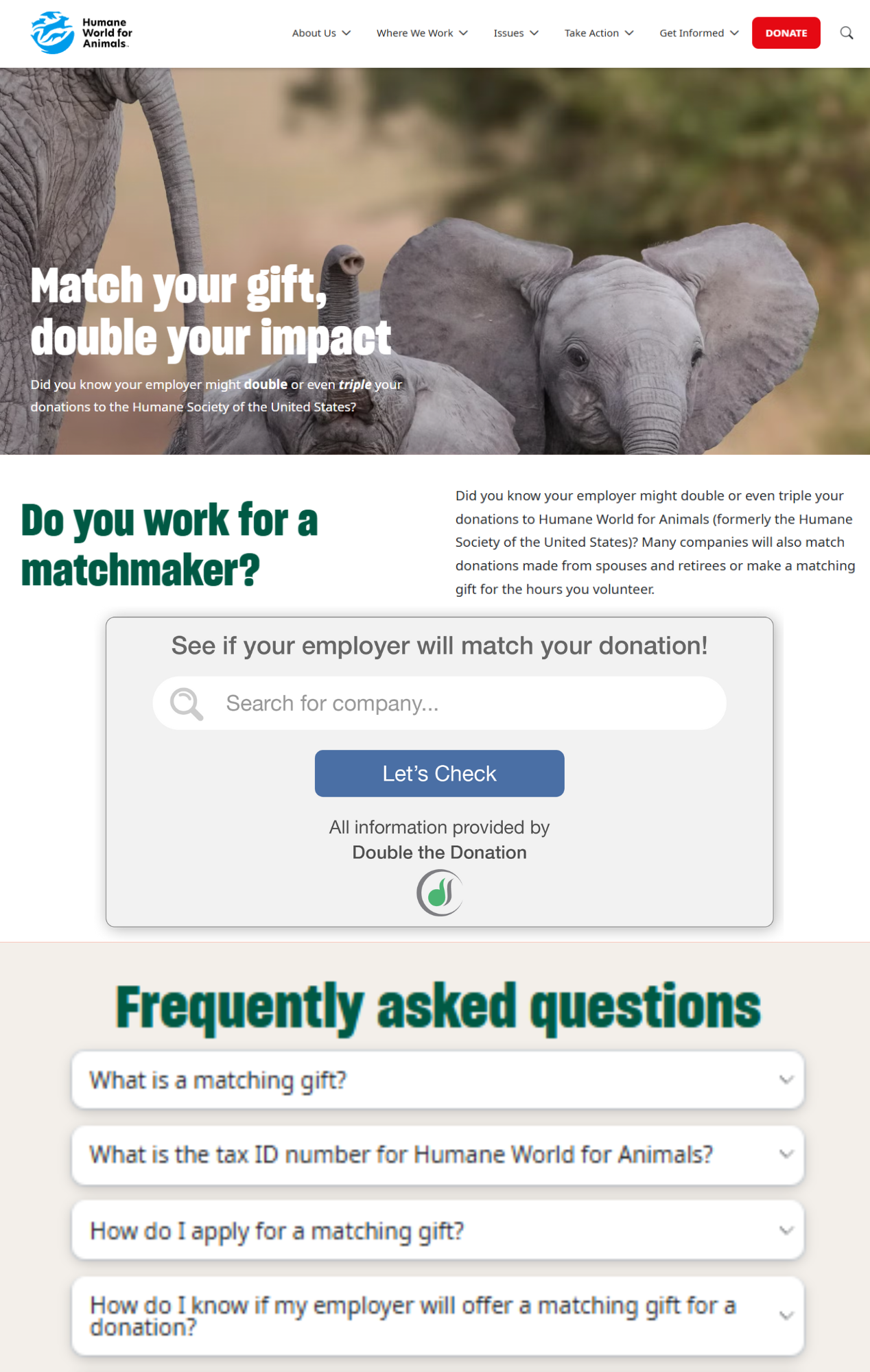
Key takeaway: A dedicated matching gifts page can serve as an educational hub for donors, providing all the information they need to take advantage of matching gift opportunities.
‘Ways to Give’ Page – Bradley University
Bradley University’s “Ways to Give” page effectively highlights matching gifts as one of the primary ways to contribute, making it easy for donors to learn about the program and take action. The page provides detailed instructions, including a call to action for checking matching gift eligibility with a simple search tool.
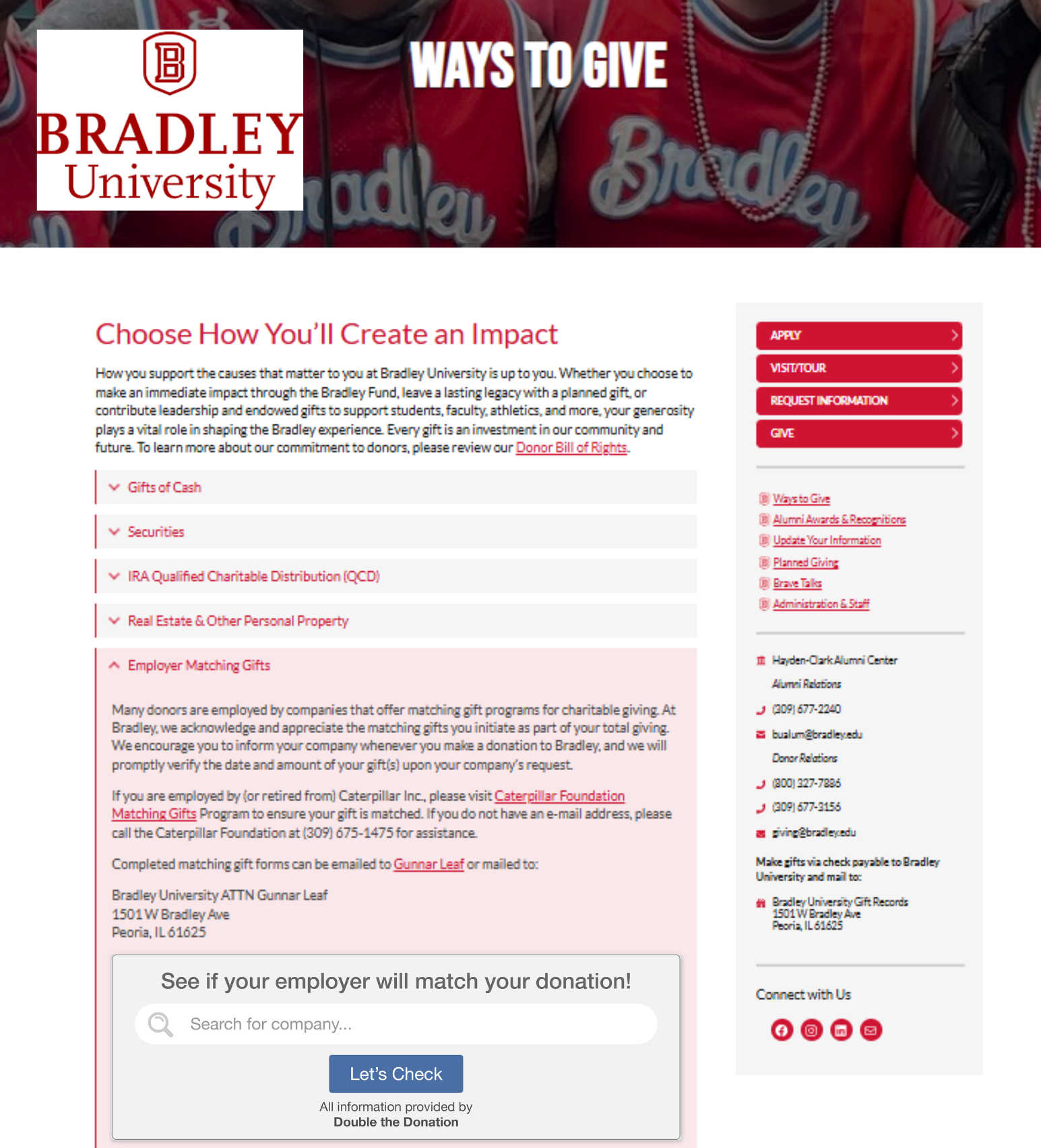
Key takeaway: Including matching gifts as one of the top giving options on your “Ways to Give” page ensures that donors are aware of the opportunity from the beginning. It’s important to provide clear, actionable steps so that donors can quickly determine if their gifts can be matched, making the donation process even more rewarding.
Workplace Giving Page – Sound Generations
Sound Generations’ workplace giving page takes a proactive approach by educating potential donors about matching gifts and providing a direct link to check if their employer offers a matching program. The page also encourages donors to reach out if their company is not listed, ensuring that the organization can continuously expand its pool of corporate partners.
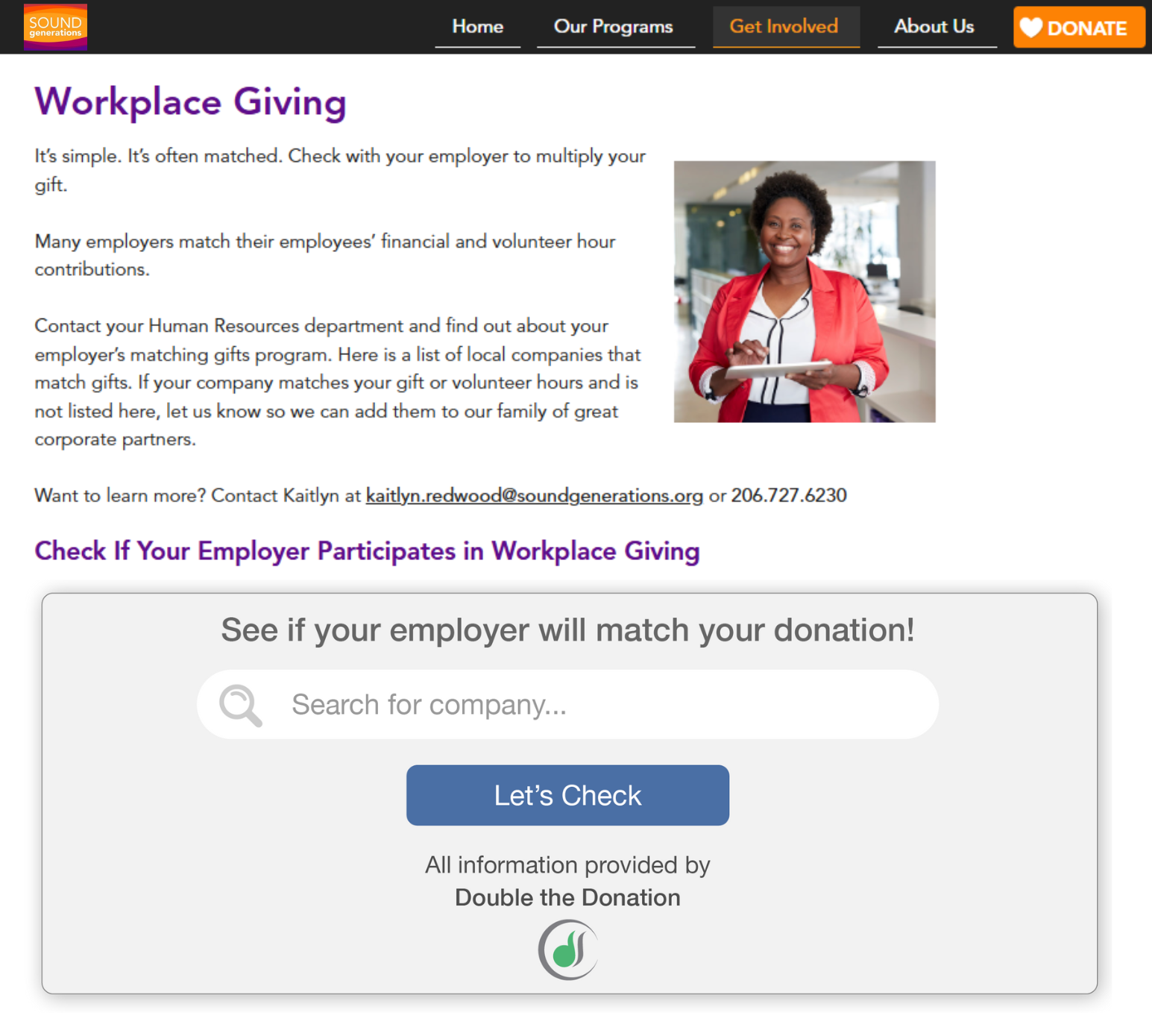
Key takeaway: A dedicated workplace giving page is an excellent way to streamline the matching gift process and get donors involved in other workplace giving programs. Providing clear instructions and encouraging donors to inquire about unlisted companies fosters a sense of involvement and increases the likelihood that donors will pursue matching gifts and beyond.
Donation Form – La Salle University
This donation form from La Salle University does an excellent job of incorporating matching gift information directly on the donation page. It includes a checkbox asking donors if their employer will match their donation, and provides an embedded search tool for them to easily find out if their employer participates in matching gift programs. By including this feature at the point of donation, the university encourages donors to check for matching gifts before they finalize their contributions.
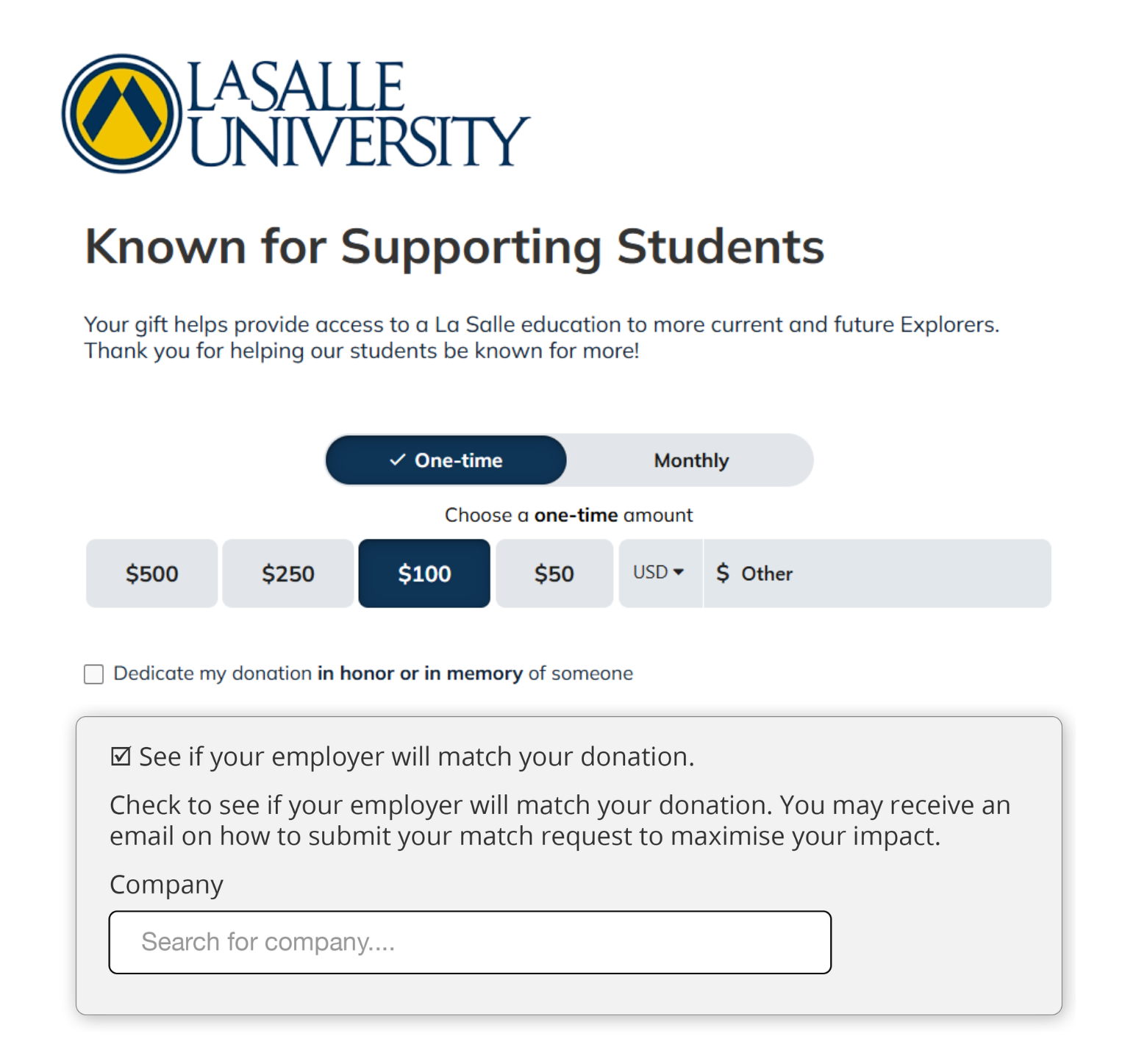
Key takeaway: Including a matching gift checkbox directly on your donation form increases the chances of donors taking the necessary steps to secure a match. Make it easy for donors to check their eligibility in real-time during the donation process, ensuring that matching gift opportunities aren’t overlooked.
Confirmation Screen – Blue Faery
After a donation is made, Blue Faery uses its confirmation screen to prompt donors to check if their employer offers matching gifts. The inclusion of a search tool right on the confirmation page makes it easy for donors to immediately follow up and maximize their contribution.
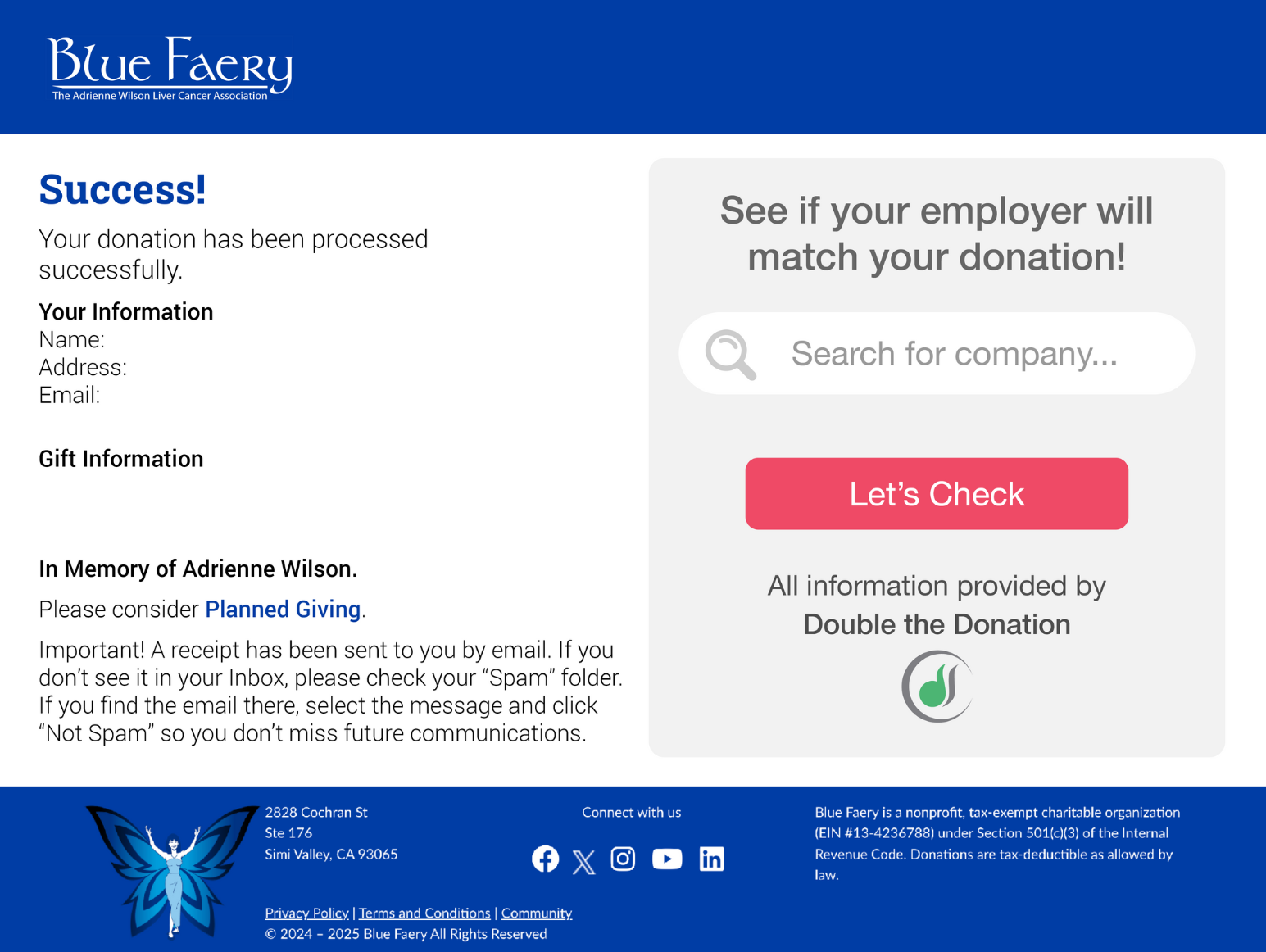
Key takeaway: By capitalizing on the moment when a donor is most engaged and the donation is fresh in their mind, you provide an easy next step for them on your confirmation screen. Incorporating a matching gift search tool on the page further simplifies the process, encouraging immediate action.
Follow-Up Email – Food For The Poor
This dedicated matching gift email from Food For The Poor is personalized and immediately relevant, reminding the donor that their employer may match their gift. The email includes simple instructions to start the matching gift process and provides a link to make it easy for donors to take the next step.
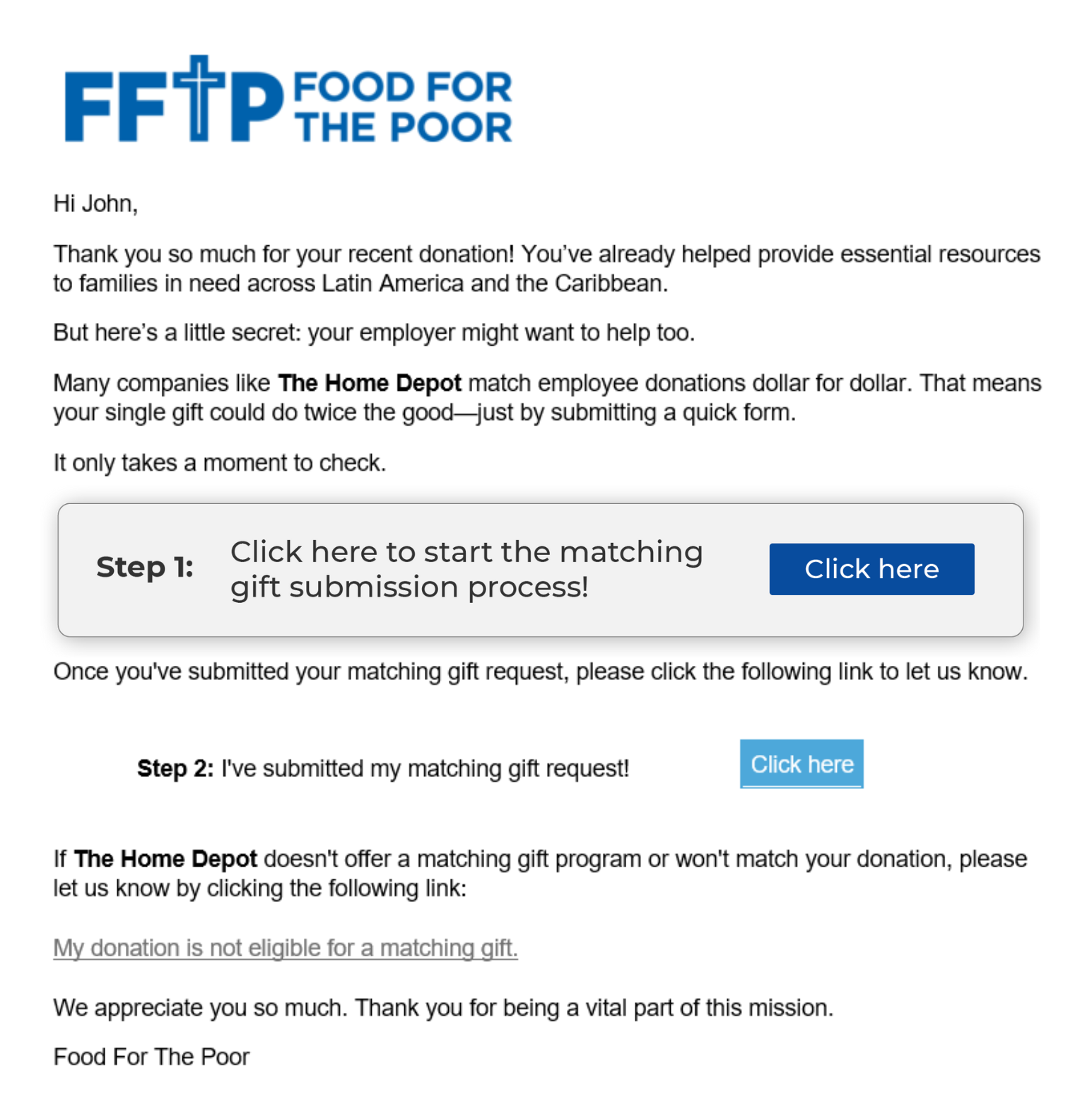
Key takeaway: Follow-up emails are crucial for ensuring donors don’t forget about matching gifts. Sending a personalized and timely reminder, right after a donation is made, can significantly increase the likelihood that donors will follow through with submitting their matching gift requests.
Email Newsletter – Food Finders
The newsletter from Food Finders effectively promotes matching gifts by providing clear information about the program, including a direct link to check eligibility. It encourages donors to double their impact by reminding them of the power of matching gifts, using a friendly tone, and offering a straightforward call to action.
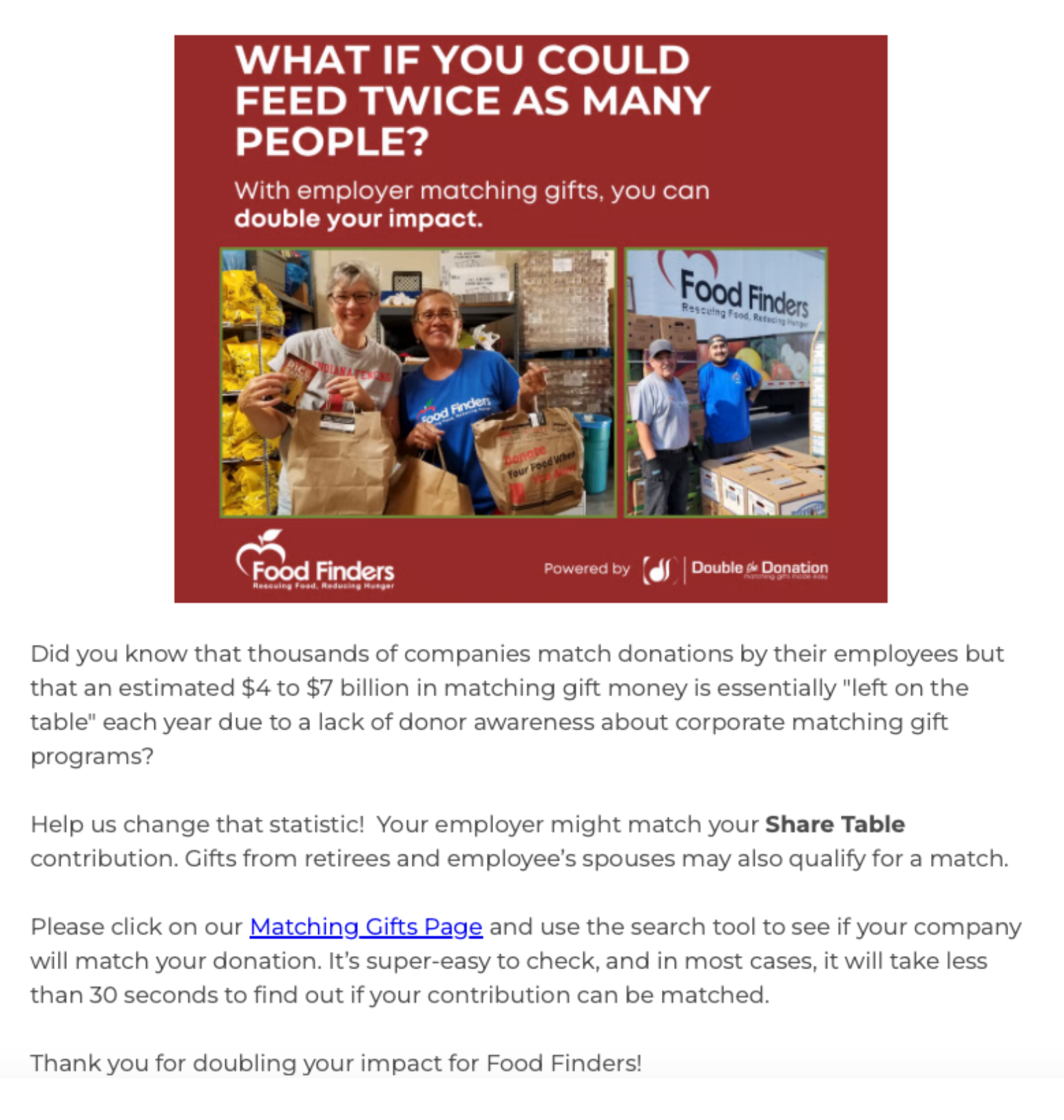
Key takeaway: Incorporating matching gift information into newsletters can be a powerful tool. By keeping the message short, clear, and actionable, nonprofits ensure donors are reminded about the availability of matching gifts. This can be easily replicated by adding a dedicated section in your next newsletter with a link to your matching gift search tool.
Social Media Post – Gateway Foundation
This social media post from the Gateway Foundation grabs attention with an impactful visual and a clear call to action. It effectively communicates the potential to “multiply your impact” through matching gifts, urging followers to check if their employer participates in such a program.
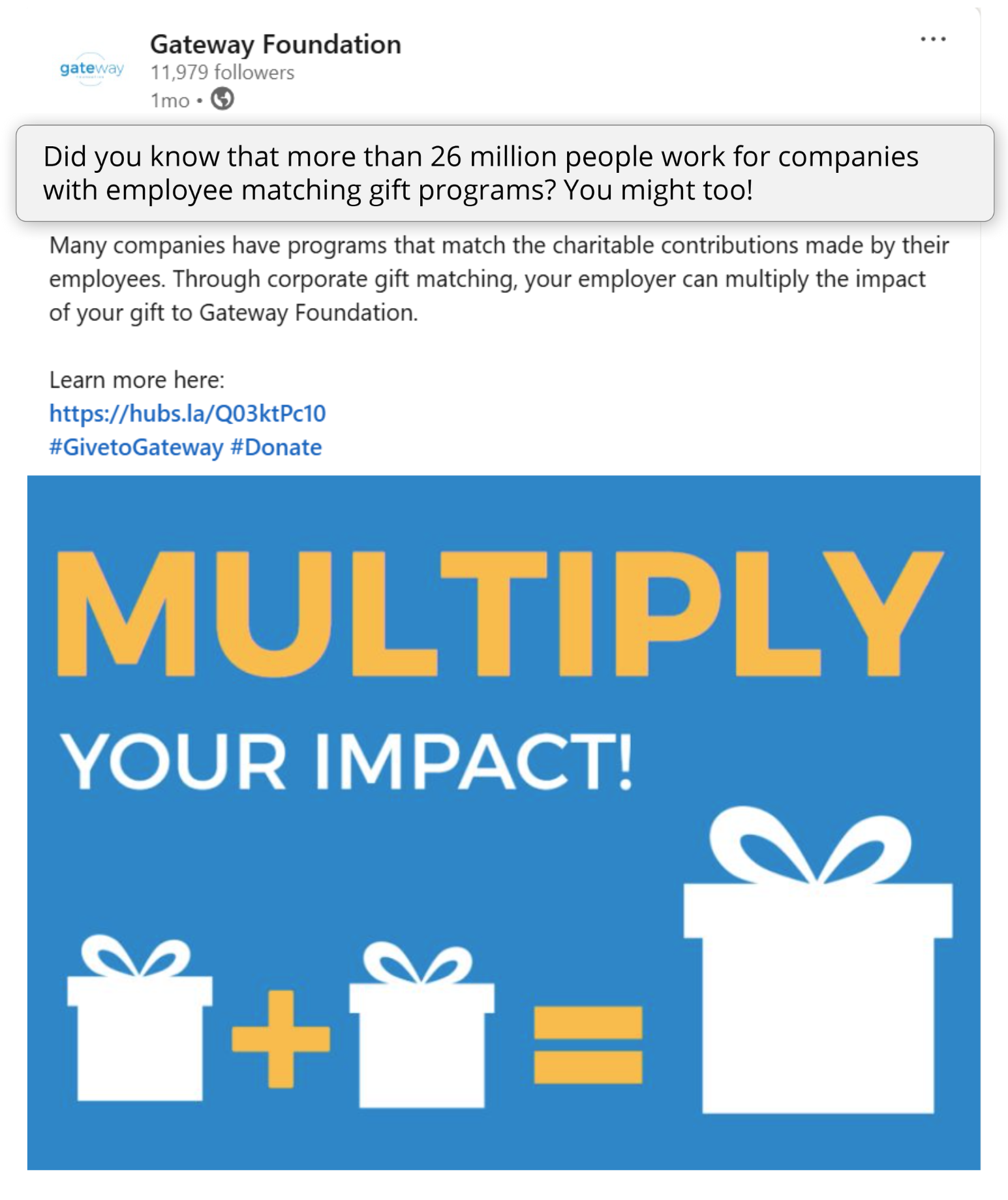
Key takeaway: Social media is a great platform to reach a wide audience and raise awareness about matching gift opportunities. Including statistics (e.g., “26 million people work for companies with matching gift programs”) makes the message even more compelling.
Direct Mailing – Randolph College
This direct mail piece from Randolph College uses a fun and engaging theme (“Score More with Matching Gifts”) and highlights the value of matching gifts with an attractive visual. It also directly informs donors that their employer may match their gift, encouraging them to look for more details in an enclosed informational sheet.
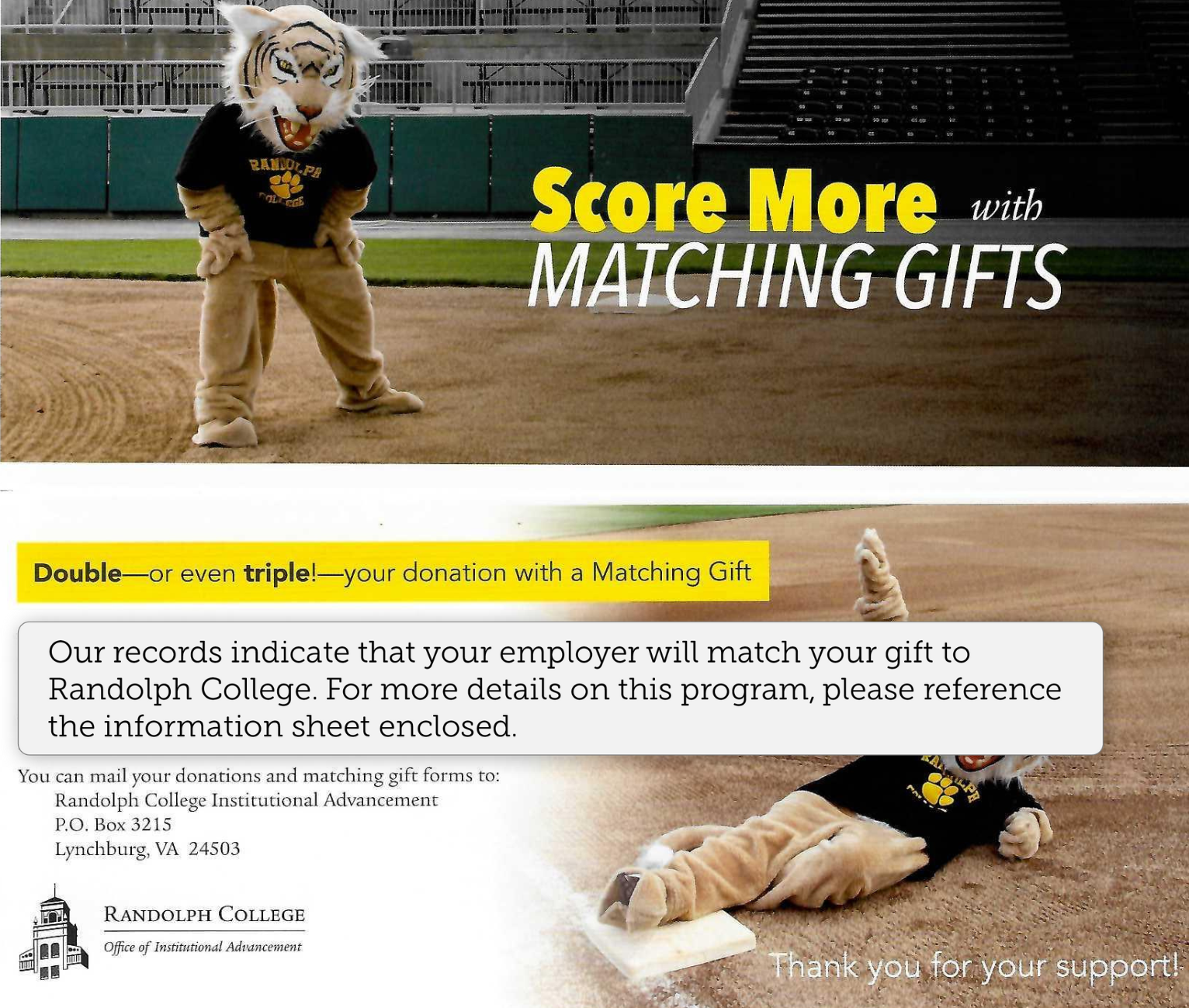
Key takeaway: Direct mail can be an effective way to promote matching gifts and break through the digital clutter, especially when it’s engaging and easy to understand. Using a clear and simple message along with matching gift forms or an information sheet ensures that donors can take immediate action when they receive your mailing.
Fundraising Appeal – Colorado Symphony
In this Colorado Symphony fundraising appeal, the organization does a great job of highlighting the matching gift opportunity right within the messaging. It emphasizes how much the donor’s contribution can be increased by their employer’s matching gift program, making the donor feel that their impact is being amplified. The call to action is clear, and the appeal includes a prompt for donors to check if their employer participates in matching gifts, making it easy for them to take action.

Key takeaway: Incorporating matching gift information directly into fundraising appeals is a smart strategy for boosting donations. By making donors aware of the opportunity to multiply their impact, you can encourage larger gifts and more engaged participation.
Blog Post – Lehigh University
This testimonial blog post from Lehigh University does an excellent job of weaving personal stories into the promotion of matching gifts. By sharing a success story of donors who have used matching gifts to amplify their contributions, the post provides social proof of how impactful matching gifts can be. This method personalizes the experience, showing potential donors the real-world impact of participating in these programs.
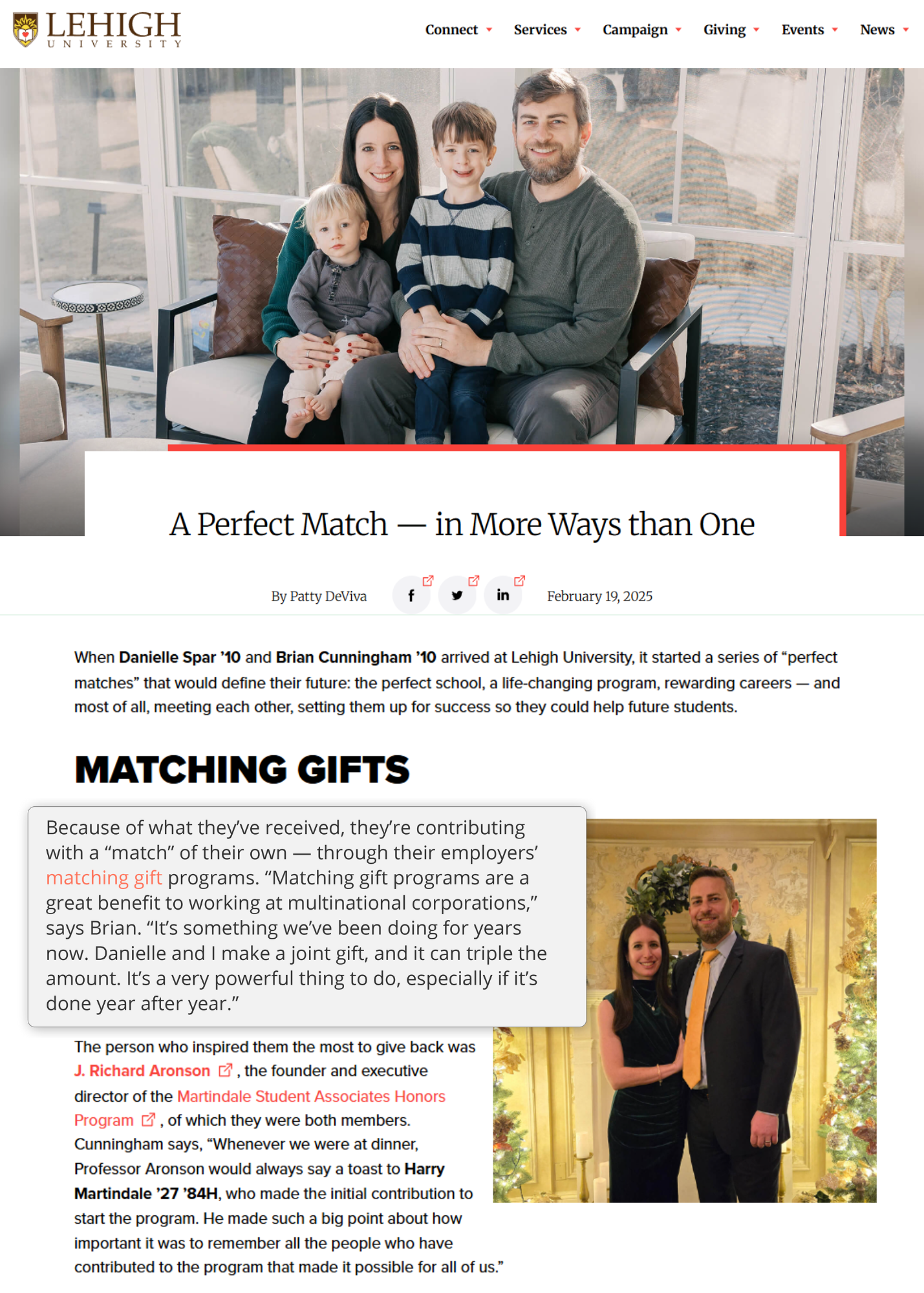
Key takeaway: Using testimonials in blog posts is a powerful way to humanize the matching gift process and demonstrate its tangible benefits. When donors see how others have successfully used matching gifts to maximize their impact, they are more likely to be inspired to take action themselves.
Email Signature – Pocock Foundation
By incorporating a matching gift reminder in an email signature, George Pocock Rowing Foundation ensures that the message is consistently communicated across all email interactions. The information is clear, and the P.S. provides an additional nudge, encouraging donors to take advantage of matching gift programs.

Key takeaway: Including matching gift details in email signatures is a low-effort but highly effective strategy. Whether in specific donor communications, thank-you emails, or routine outreach, this simple addition can increase awareness and encourage more donors to inquire about matching gifts.
Navigation Menu – Resolve
In this example, the matching gift option is prominently featured in Resolve’s navigation menu. By adding “Employee Matching Gifts” as a visible and easy-to-access option, the organization ensures that visitors can quickly find information about matching gift opportunities. This method of placement increases visibility and encourages visitors to explore the matching gift process at any point during their visit to the site.
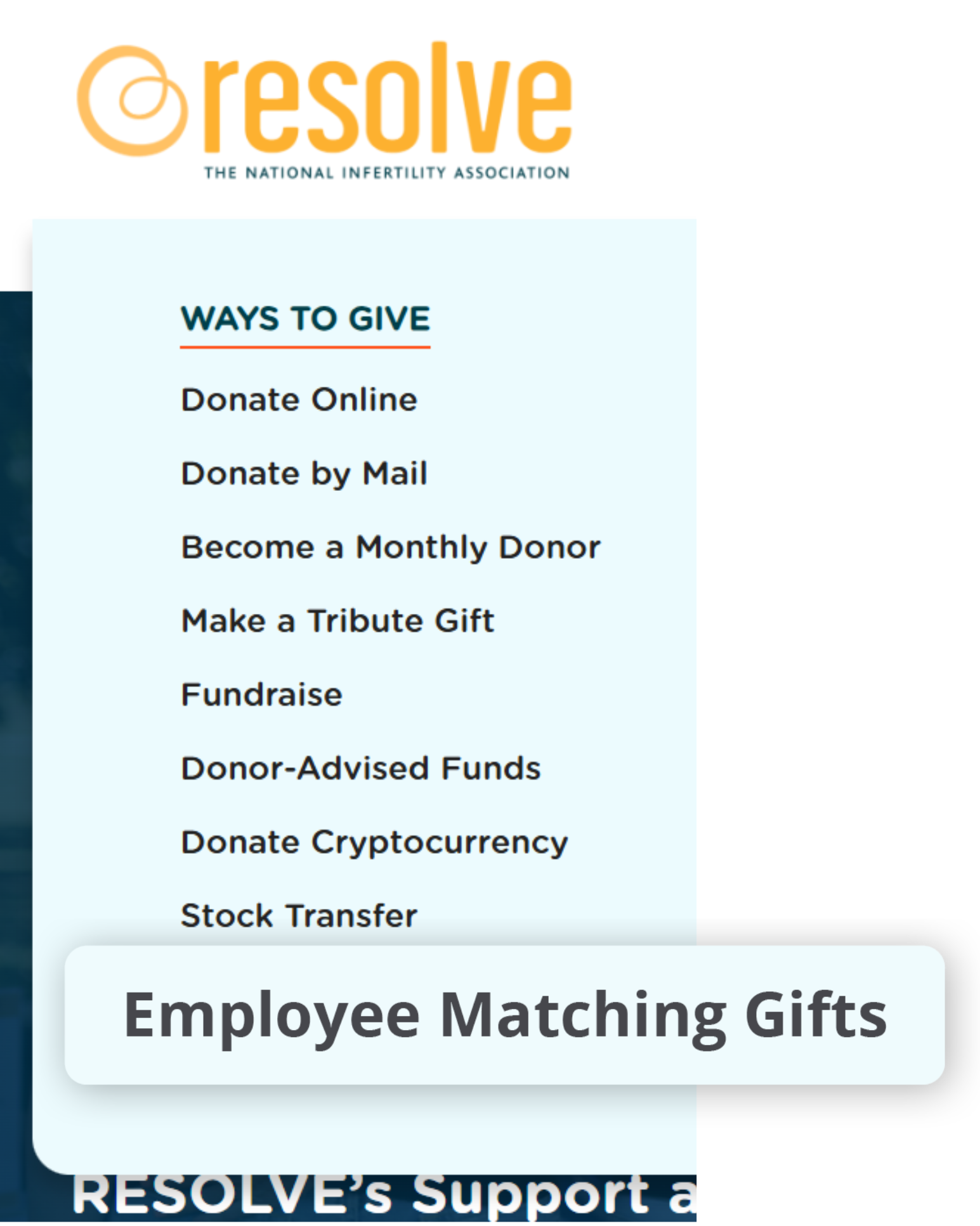
Key takeaway: Incorporating matching gifts directly into the website’s main navigation menu ensures that it is always visible and easy for visitors to find. This subtle but effective placement increases awareness and encourages potential donors to take action without needing to search for information.
Magazine Ad – The Nature Conservancy
The magazine ad from the Nature Conservancy effectively promotes matching gifts with a catchy phrase and an informative description of how matching gifts can double or even triple a donation. It’s visually appealing and includes all necessary information without overwhelming the reader.
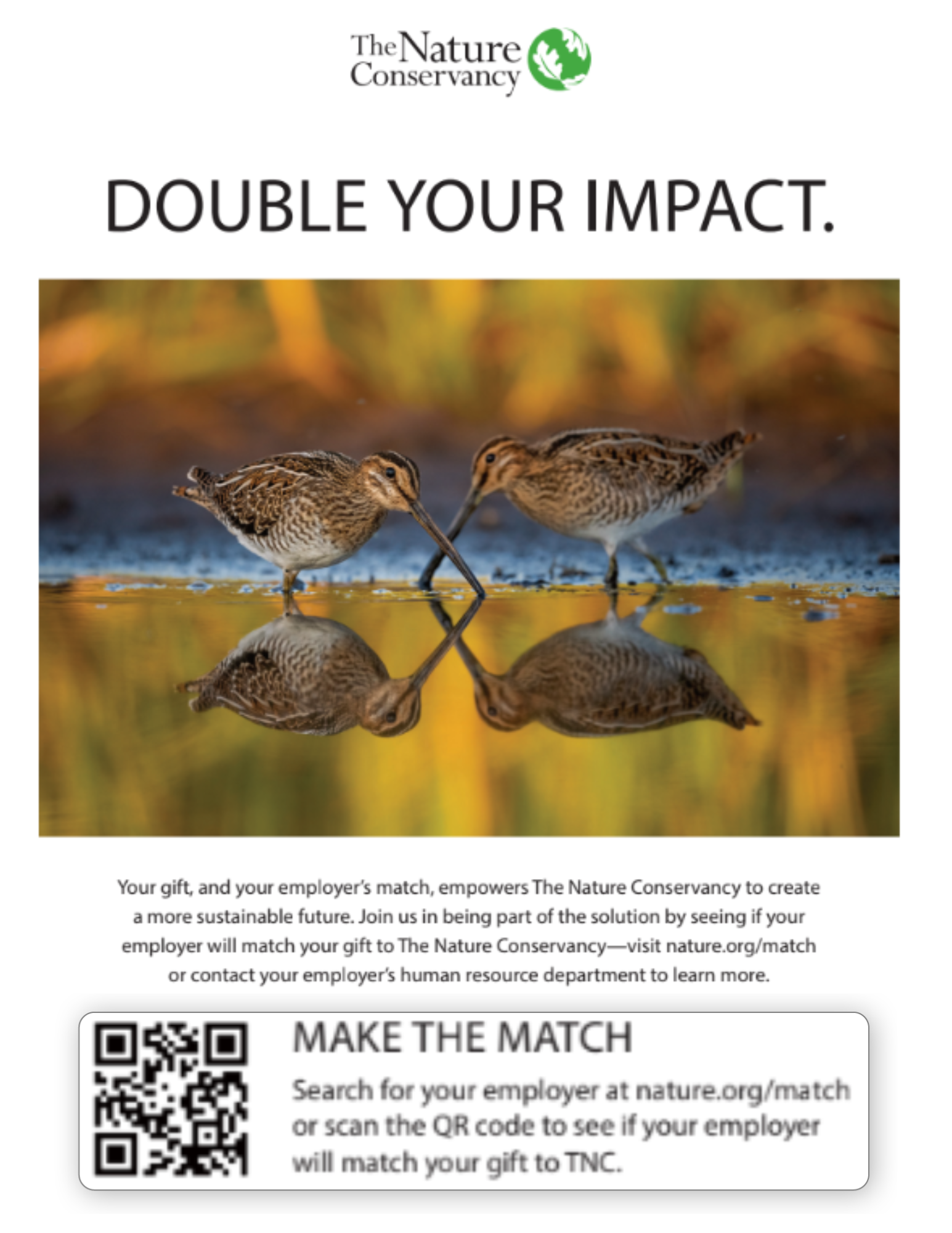
Key takeaway: Magazine ads can be a great way to target specific audiences, especially if the ad is placed in publications read by potential supporters. Keeping the message concise while focusing on the value of matching gifts ensures that the reader quickly understands the benefit and is encouraged to take action.
Incentive-Based Match Drive – Scouting America
The matching gift drive hosted by Scouting America emphasizes the importance of matching gifts in a dynamic and community-focused way. It clearly communicates the steps for getting involved and encourages donors to check if their employer will match their contribution, providing an extra incentive with a reward (branded Scouting America socks).
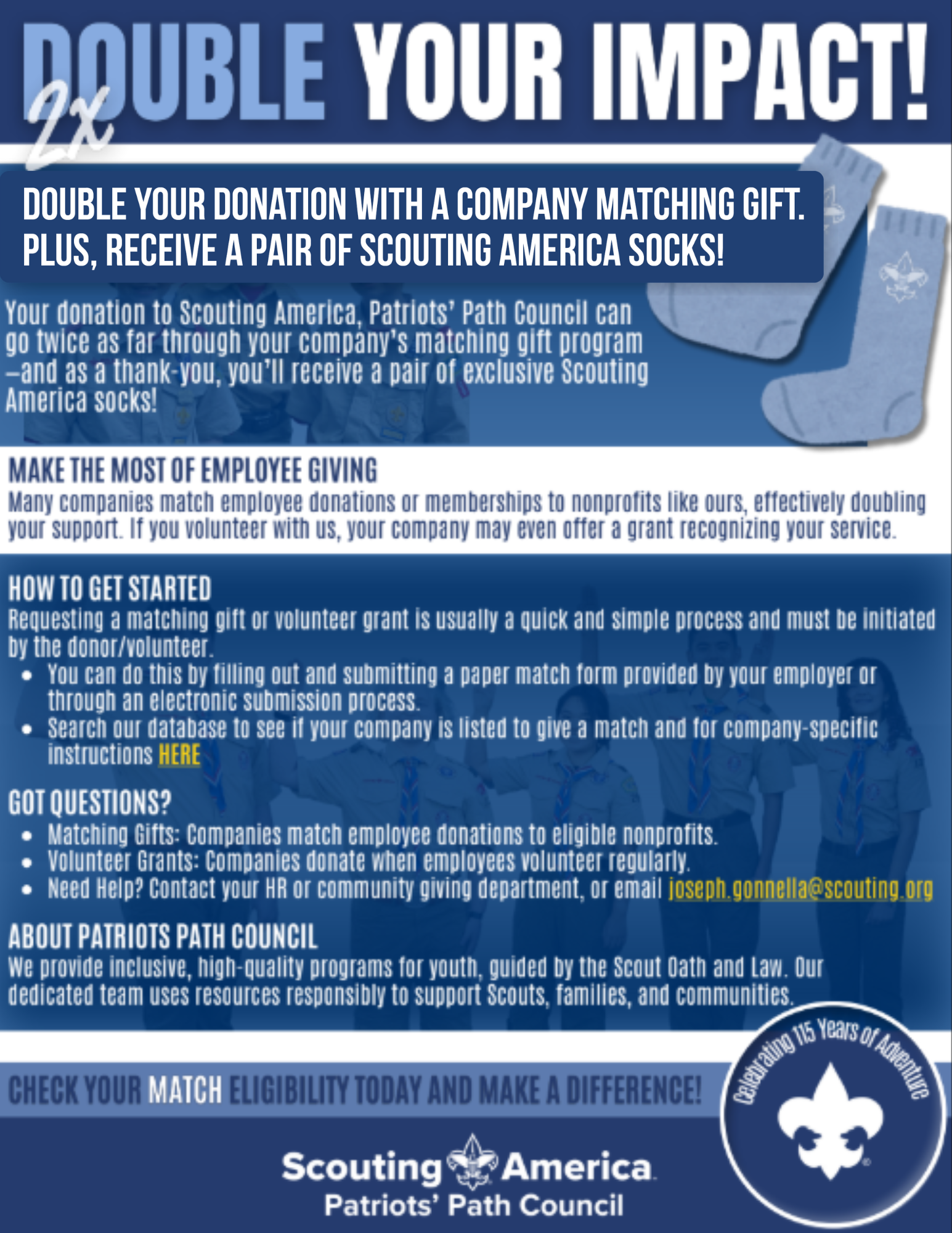
Key takeaway: Match drives with an engaging incentive (like exclusive rewards) can spark excitement and increase participation. Nonprofits should create clear campaigns with defined goals and encourage donors to participate in matching gift programs to achieve those goals.
Archives: Top 2024 Submissions
We also received a ton of inspirational matching gift submissions in the first year we held the Matching Gift Idea Exchange in 2024. Here, we selected a few leading examples to showcase. Check them out below, and see which best practices your team can incorporate.
1) Supplement your match page with video content.
An organization’s matching gifts page is one of its most invaluable assets, especially when it comes to marketing matching gifts effectively. Implementing the right content on the page is essential for driving more matches to completion!
What this Organization Did Well:
The OKCMOA, or the Oklahoma City Museum of Art, has embedded a one-minute informational video on its matching gifts page. This resource, submitted by the organization as part of our Matching Gift Idea Exchange, provides a quick overview of the matching gift opportunity, its benefits to nonprofits, and how donors can determine their eligibility and next steps using Double the Donation’s matching gift database, embedded above.
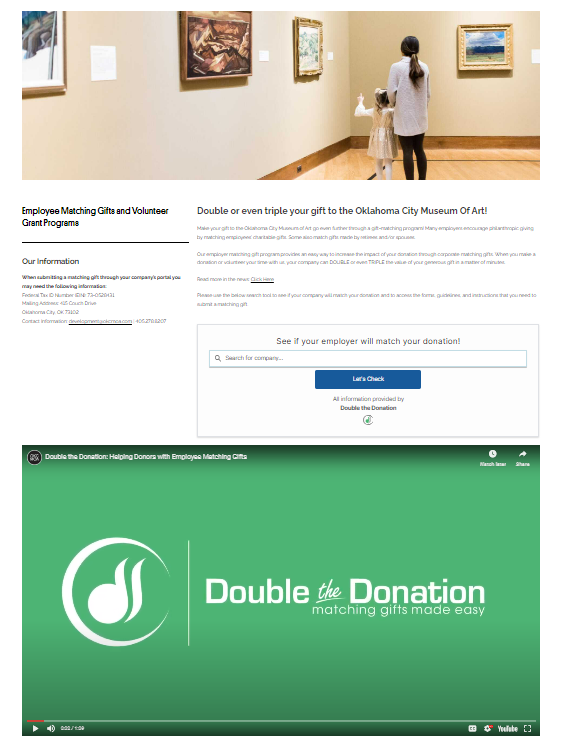
Best Practice For Your Team:
Take a multimedia approach to your organization’s dedicated matching gifts page. We recommend incorporating a combination of text, video, and graphic elements to grasp best and retain your audience’s attention while they learn about matching gifts on your site.
Double the Donation clients can access a free, pre-made matching gift video (plus a ton of other graphics and materials) or request a custom-branded version for a fee within the platform.
2) Make the page accessible from your site navigation.
It hardly matters how well-designed your matching gifts page is if no donors can locate it on your website. That’s why making your information easily accessible is a must! Prominently featuring matching gifts on your navigation menu ensures a seamless donor experience and underscores the importance of matching gifts in your fundraising efforts.
What this Organization Does Well:
Blue Faery (the Adrienne Wilson Liver Cancer Association) makes matching gift information easy to locate. All a user has to do is access the drop-down menu from the main “Donate” button and select “Matching Gifts.”
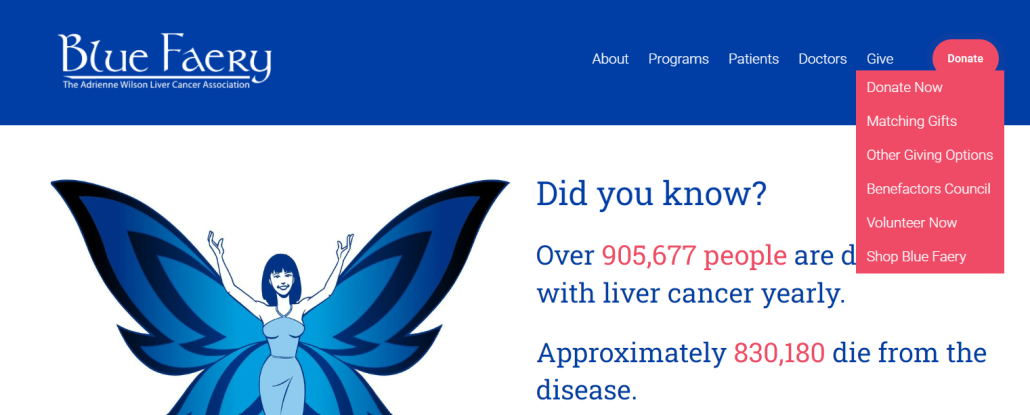
Best Practice For Your Team:
Add a link to your matching gifts page to your main site navigation! Feel free to nest it under relevant parent pages, such as your “Donate” button or “Ways to Give” compilation, for the best results.
3) Host a matching gifts tool on event pages, too.
Sometimes, an organization will host separate event pages or microsites to market upcoming opportunities (hint: this is a fairly common practice for run/walk/ride events and other peer-to-peer fundraisers). If that’s the case for your team, you’ll want to be sure you’re promoting matching gifts throughout your event pages as well; after all, those gifts are often eligible to be matched, too.
What this Organization Does Well:
The Hirshberg Foundation for Pancreatic Cancer Research is a largely peer-to-peer-based organization, with a significant portion of its revenue generated from large-scale fundraising events, such as the annual Tour de Pier. To ensure that eligible gifts are successfully matched, the nonprofit has implemented a Matching Gifts page on its event microsite, complete with a matching gift search tool and an overview of the programs.
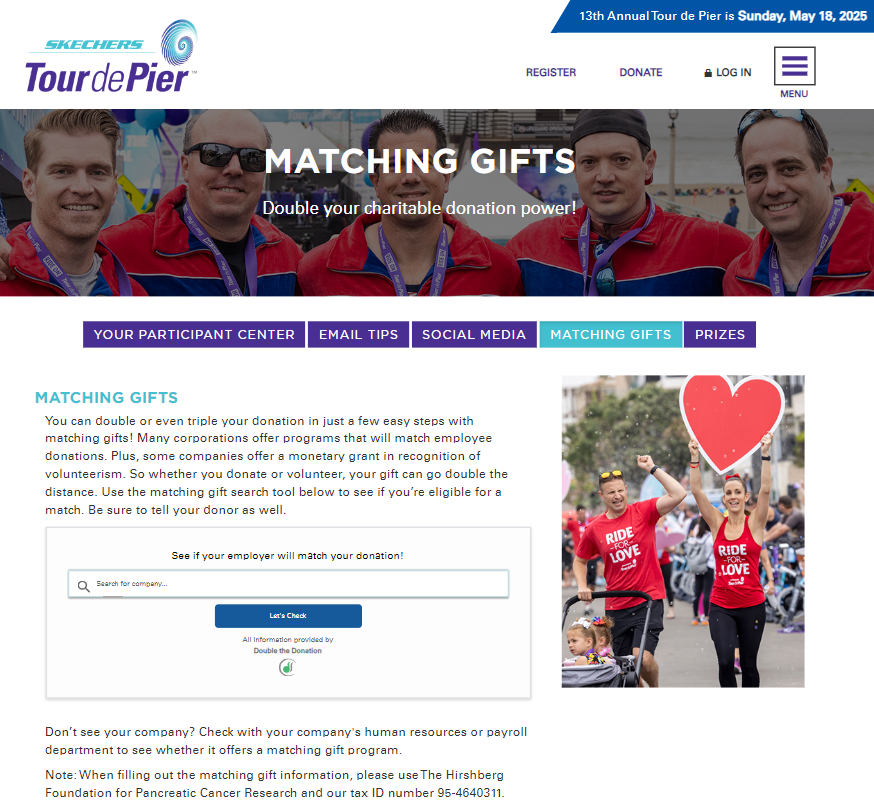
To mitigate any confusion, the fundraising team even provides the correct name and tax ID number that an individual should use when submitting their matching gift requests.
Best Practice For Your Team:
At the very least, mention matching gifts with a dedicated callout on your event or campaign pages. Even better? Establish a separate matching gifts page on your event site to ensure your audience is exposed to the idea and provided with the necessary information to get started.
4) Meet your donors where they are with SMS messaging.
According to Nonprofit Source, mobile donations have increased by more than 205% in the past year, and 51% of nonprofit website traffic originates from mobile devices.
What does that mean for you? Your donors’ phones are where they are, and you can meet them there with text message engagement strategies.
What this Organization Does Well:
This text message campaign from Save the Children demonstrates the ease with which a matching gift can be requested right from a donor’s mobile device. An individual receives one or both of the texts below and can initiate their match without hesitation simply by clicking the provided link. Talk about frictionless giving experiences!
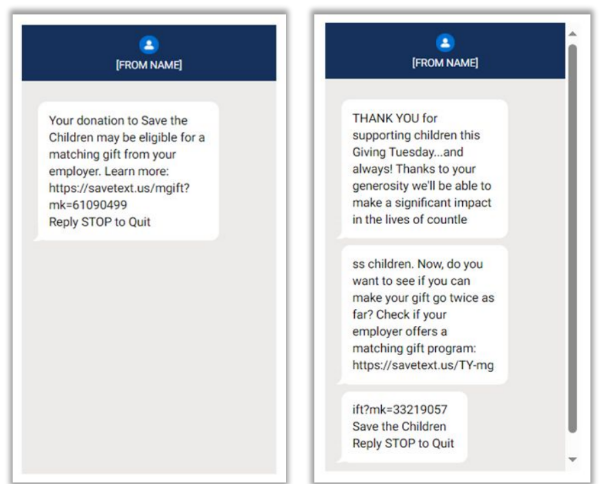
Best Practice For Your Team:
Take a multi-channel engagement approach by incorporating SMS into your outreach strategy, alongside standard follow-up emails and other methods.
Note: Double the Donation offers automated SMS messaging for its Enterprise-level users. Interested? Learn more about upgrading your account here.
5) Leverage direct mail to promote matching opportunities.
In today’s digital world, it can be easy to forget about the power of direct mail marketing. However, incorporating snail mail into your matching gift promotional strategy can have a significant impact.
What this Organization Does Well:
Scripps College utilizes beautifully designed, eye-catching direct mail cards to draw its supporters’ attention to matching gifts. And, to empower donors to take the following steps without delay, the institution implements a scannable QR code that directs recipients to its online matching gifts page.
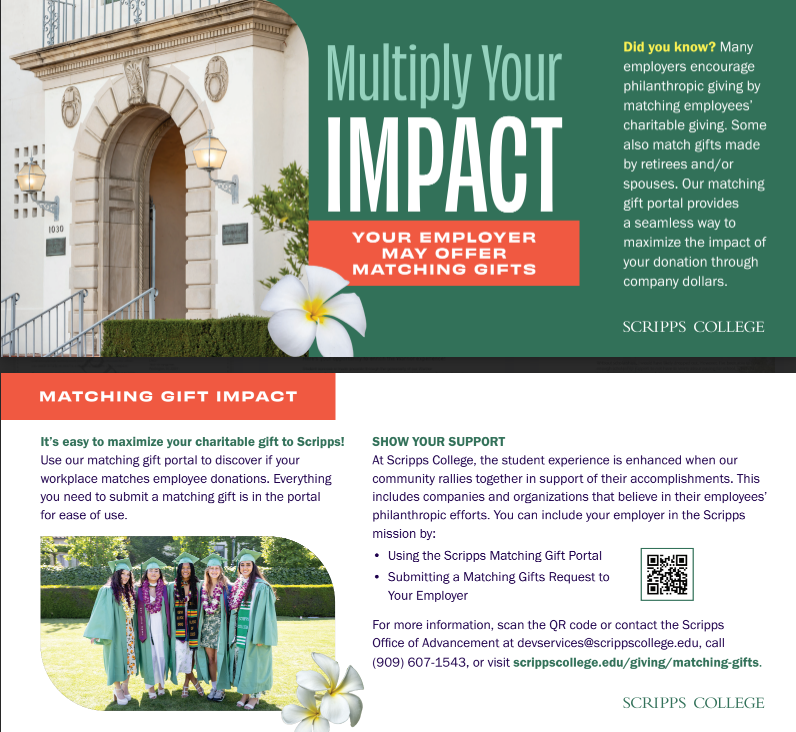
Best Practice For Your Team:
Diversify your messaging with direct mail! If you already have a direct mail fundraising package going out, try adding an insert dedicated to matching gifts. Otherwise, consider a matching gift-focused postcard to spread the word.
6) Pair corporate matching with matching gift challenges.
Did you know that corporate or employee matching gifts represent only a single form of matching donation opportunity an organization might have? Matching gift challenges, also known as major donor matches, can play a significant role in boosting a nonprofit’s fundraising efforts. And they’re typically not mutually exclusive, either, meaning donors can have the chance to multiply their gifts twice!
What this Organization Does Well:
UWC-USA noted in the Matching Gift Idea Exchange that it combines the power of corporate matching gifts with other forms of donation matching, including major donor matching gift challenges. In a campaign, interest is typically generated by offering a major donor match. Then, once supporters have navigated to the campaign page, UWC also promotes corporate matching gift opportunities.
The results? The organization reported that campaign revenue is typically about 30% higher for those with a matching gift offer than for those without one. Additionally, a significantly higher percentage of donors check to see if their companies offer a donation match.
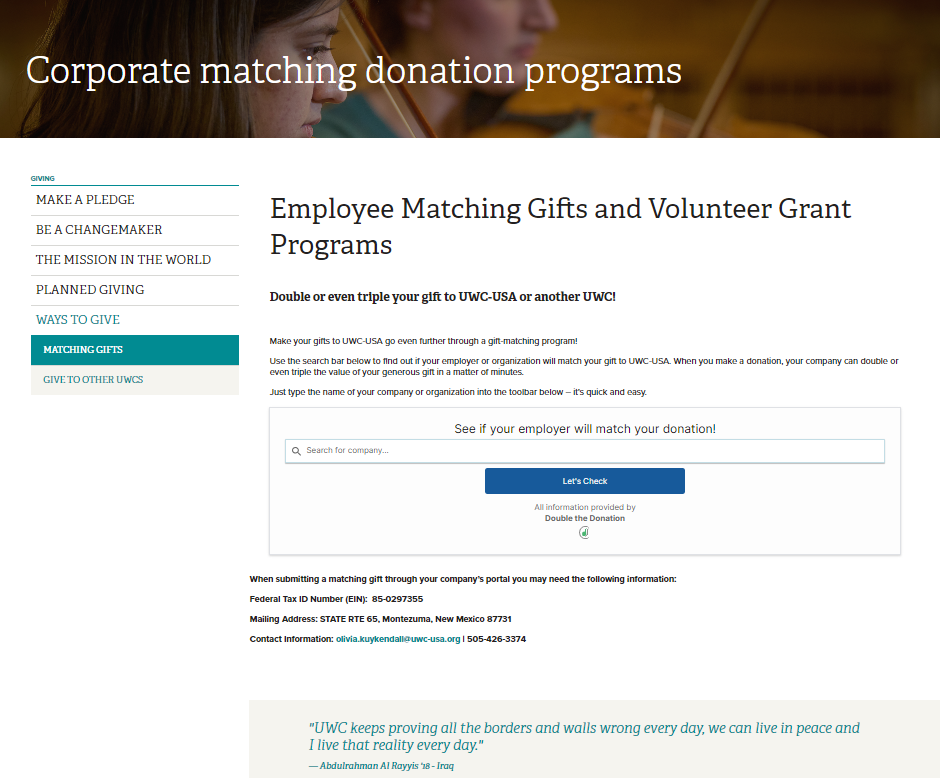
Best Practice For Your Team:
Try running a double-matching campaign! If you can find a major donor willing to put up a significant match amount, leverage that opportunity in addition to corporate matching gifts to get donors’ gifts multiplied again and again.
7) Thoroughly thank donors for matching their gifts.
There are many moving parts when it comes to getting a gift matched. Thanking your donors for their involvement allows you to communicate your gratitude and close the loop at each step of the process.
What this Organization Does Well:
UNCF makes a concerted effort to thank its matching gift donors at multiple touchpoints throughout the supporter journey. This includes upon the submission of their matching gift request and after the company has paid out the matching donation.
To best capture the recipient’s attention and convey their message, the organization uses a well-designed postcard (or two!).
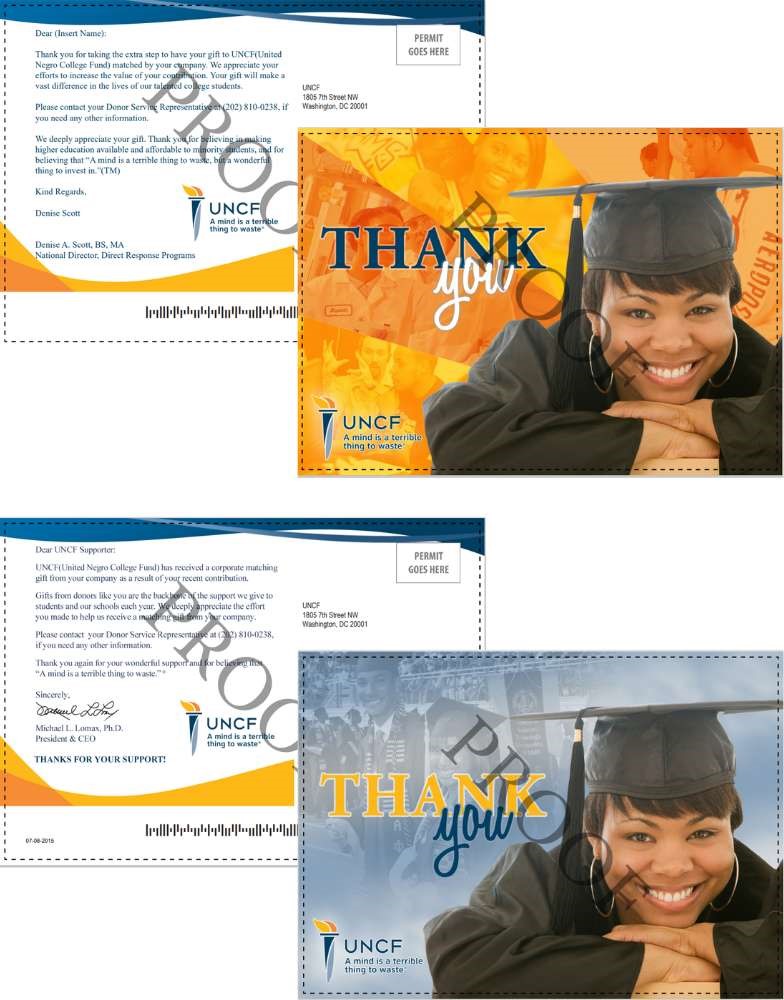
Best Practice For Your Team:
Showing appreciation is essential for any donor relationship, and communicating gratitude to your matching gift donors is crucial for retaining their support in the long run. As you do so, remember that they went above and beyond in requesting a matching gift. You, too, should go above and beyond in your thanksgiving.
8) Acknowledge companies that match to your cause.
When thanking donors for matching gifts, it’s generally recommended to focus your efforts on the individual who requested the match. However, acknowledging the company (i.e., the entity that pays out the match) can also go a long way in building long-term relationships.
What this Organization Does Well:
Michigan Technological University uses its matching gifts page to highlight leading matching gift companies that have contributed to the school in the past year. This way, the listed companies can feel the appreciation of their support, and donors accessing the page can gain at-a-glance insights into the top matching gift companies in their network.
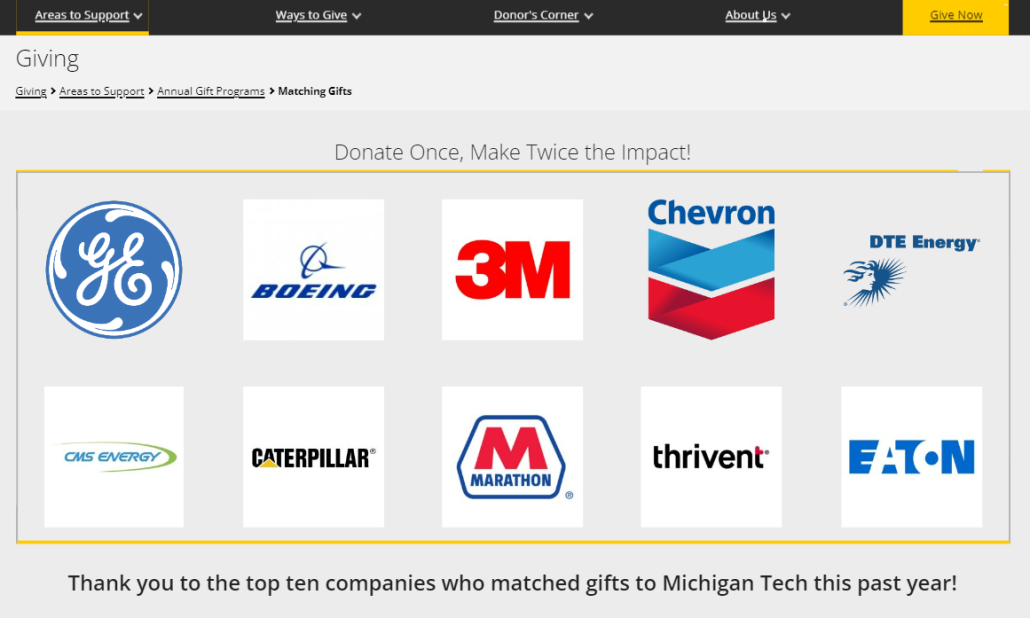
Best Practice For Your Team:
Shine a spotlight on examples of companies that have supported your cause with matching gifts in the past. Not only is this an excellent way to thank these matching gift contributors (with additional publicity), but it can also inspire more donors (from the spotlighted companies and otherwise) to want to get involved.
9) Promote matching through personal and mass emails.
More than likely, email makes up a significant portion of your supporter engagement strategy. There are emails you send to all donors (mass marketing) and those you send individually. For the best matching gift results, consider a mix of both types of outreach to grab your audience’s attention and drive more submissions to completion.
What this Organization Does Well:
Save the Boundary Waters employs a multifaceted approach to promoting matching gift opportunities through targeted email marketing. When a donor gives, they receive a personalized copy of the automated email (powered by Double the Donation) on the left. This encourages them to pursue a match for their recent gift while they are still at the height of their engagement with the organization.
Additionally, the team regularly promotes matching gifts through a segment of its digital newsletter, which is sent to all donors on the right. This enables the organization to raise awareness of its programs across its entire audience simultaneously.
Best Practice For Your Team:
Double the Donation research indicates that organizations that send a single matching gift email see an estimated 31% of eligible donations submitted for matching. Meanwhile, a second reminder email increases submissions by 45%, and a third email brings the total percentage of submitted eligible gifts to 49%.
So, what does that mean for you? To engage the most significant number of donors and achieve the best results, incorporate more than one matching gift email into your follow-up cadence. For even better results, vary the formatting and structure between newsletters, email blasts, personal reminders, and more.
10) Turn corporate matching into a dedicated campaign effort.
Rallying support around matching gifts can significantly amplify the support received from donors. Generating enthusiasm through campaigns, events, and other dedicated communications can significantly increase awareness and participation in the programs.
What this Organization Does Well:
In this final submission from the Matching Gift Idea Exchange, Community Ministry has launched a dedicated campaign effort called the “Hunger Heroes.” This initiative included a campaign logo, a one-pager overviewing the opportunity and outlining how donors can get involved, an email blast, and several related social media posts.
Donors whose gifts are matched by their employers then earn the “Hunger Heroes” designation, celebrating their above-and-beyond support and leveraging social proof to drive additional engagement in the campaign.

Best Practice For Your Team:
Make matching gifts fun and exciting by adding a layer of novelty. Try providing donors with a digital “Matching Gift Donor” certificate or hosting an event alongside a big matching gift push.
Final Thoughts & Next Steps
As the above examples from the Matching Gift Idea Exchanges demonstrate, there are numerous ways for nonprofits and schools to innovate and enhance their matching gift efforts. By implementing the strategies highlighted above, organizations can unlock additional funding, strengthen relationships with donors, and drive greater community impact.
All in all, we hope these insights have inspired you to bring your matching gift efforts to new heights. Stay tuned to participate in the Matching Gift Idea Exchange next year!
In the meantime, check out these additional resources to grow your knowledge of all things matching gifts:


10 Tips to Boost Corporate Matching Gift Participation
/in Donor communications, Fundraising Ideas, Marketing Strategies, Learning Center /by Adam WeingerCorporate matching gifts are a powerful yet often underutilized resource for nonprofits. In essence, matching gifts are donations that companies make to match the contributions of their employees, effectively doubling (or even tripling!) the original amount given. Imagine a donor gives $100 to your organization. With corporate matching gift participation, that $100 donation could quickly become $200 or more—without the donor needing to give anything extra.
For nonprofits, matching gifts can be a game-changer. Not only do they increase total donations, but they also deepen the impact of individual contributions, helping nonprofits reach their fundraising goals faster. Despite this potential, many nonprofits miss out on corporate matching gift opportunities simply because donors are unaware of the process or how to participate. That’s where strategic marketing comes in.
This article will explore 10 effective marketing practices specifically tailored to nonprofits looking to boost participation in corporate matching gift programs. From educating your donors to leveraging digital marketing and building corporate partnerships, these insights will help you maximize every donation’s potential—ultimately bringing in more funds to fuel your mission. Let’s dive into how you can unlock the power of corporate matching gifts!
1. Educate Your Donors on Matching Gift Programs
The first step in increasing corporate matching gift participation is ensuring your donors understand what matching gifts are and how they work. Surprisingly, many donors may not be aware that their contributions can be matched by their employers, leaving valuable funds on the table. Educating your supporters transforms their understanding and engagement with matching gifts, empowering them to amplify their impact without spending a dollar more.
Tips to Educate Your Donors:
2. Utilize Targeted Email Campaigns
Email marketing is a highly effective way to raise awareness about corporate matching gifts. Well-targeted campaigns allow you to deliver relevant information to donors at the right time, encouraging them to double their contributions.
Tips for Effective Email Campaigns:
3. Highlight Matching Gifts on Your Donation Page
Your donation page is where the magic happens—it’s where supporters take that meaningful step to give. So, why not use this key moment to inform them about matching gift opportunities? Adding information about matching gifts on your donation page is a simple yet effective way to boost awareness and encourage donors to maximize their contributions.
Tips for Featuring Matching Gifts on Your Donation Page:
4. Leverage Social Media Outreach
Social media is one of the most effective ways to get the word out about matching gifts. By meeting your supporters where they already spend time, you can amplify awareness, build excitement, and encourage more people to take advantage of these opportunities to maximize their impact.
Tips for Promoting Matching Gifts on Social Media:
5. Engage Corporate Partners
Engaging with corporate partners who offer matching gift programs can greatly enhance your nonprofit’s fundraising efforts. By building strong, mutually beneficial relationships with these companies, you’re not only supporting your cause but also giving businesses a meaningful way to engage with their employees and the community.
Tips for Engaging Corporate Partners:
6. Create a Dedicated Matching Gifts Page on Your Website
A dedicated matching gifts page on your website can be a valuable resource for donors, helping them understand and take advantage of matching gift opportunities. By providing clear, easy-to-access information, you’re empowering donors to maximize their contributions—boosting support for your mission without any extra cost to them.
Tips for Creating an Effective Matching Gifts Page:
7. Simplify the Matching Gift Process
When it comes to encouraging donors to participate in corporate matching gift programs, simplicity is key. If the process seems complicated or time-consuming, donors might feel discouraged from taking that extra step—even if they’re eager to amplify their impact. By removing barriers and making the matching gift process as straightforward as possible, you can significantly increase participation rates.
Tips to Simplify the Matching Gift Process:
8. Use Data to Target High-Value Donors
Data is one of the most powerful tools for nonprofits aiming to make the most of corporate matching gift programs. By using data-driven strategies, you can identify high-value donors, segment them effectively, and encourage more impactful contributions through matching gifts. This approach allows you to focus your resources where they’ll have the greatest return.
Data-driven strategies help optimize efforts by identifying donors whose employers offer matching gift programs, allowing targeted outreach to maximize contributions. By segmenting donors based on matching gift eligibility, organizations can streamline marketing, ensuring the right message reaches the right audience. This targeted approach enhances the donor experience, making communication more relevant, personal, and impactful.
Tips for Identifying and Targeting High-Value Donors:
9. Thank Donors and Acknowledge Their Impact
Expressing gratitude is essential for maintaining donor relationships and encouraging future engagement. When donors take the extra step to submit a matching gift request, recognizing their effort can go a long way.
Tips for Thanking Donors:
10. Regularly Review and Improve Your Strategy
As donor behavior and corporate policies evolve, it’s important to regularly review and refine your marketing strategies for corporate matching gifts. Continuous improvement ensures that your efforts remain relevant and effective.
Tips for Reviewing Your Strategy:
Final Thoughts
Corporate matching gifts present a unique opportunity for nonprofits to double—or even triple—their impact. However, many organizations fail to fully capitalize on these programs due to a lack of awareness or effective strategy. By implementing the best practices outlined above, you can turn matching gifts into a reliable source of funding while deepening donor engagement.
Key Takeaways:
By following these steps, your nonprofit can unlock the full potential of corporate matching gifts, amplifying every donor’s contribution and making a greater impact.
eTeamSponsor and Double the Donation Partner to Provide New Matching Gift Solution
/in Press Releases, Company Updates /by Adam WeingerDouble the Donation is excited to announce a new partnership with eTeamSponsor that will provide organizations with integrated matching gift solutions. With the integration between eTeamSponsor’s innovative FundRaker platform and Double the Donation’s Double the Donation, fundraisers are equipped to raise more from corporate matching gift programs.
With the FundRaker and Double the Donation integration, donors can enter their employer information as they give, effectively discovering their matching gift eligibility during the donation process. Following the donation submission, donors receive actionable next steps to submit their matching gift request.
“With billions of dollars in matching gift funding going unclaimed annually, Double the Donation is a valuable asset when it comes to identifying eligible donors and driving matches to completion,” said Adam Weinger, President at Double the Donation. “We’re excited to see how eTeamSponsor and Double the Donation users will increase their fundraising with the power of this new integration.”
The eTeamSponsor and Double the Donation integration is now available for mutual client use. Follow our integration guide to get connected!
Ready to get started with Double the Donation and add matching gifts to the donation experience? Request a demo with us, and make sure to share that you are an eTeamSponsor user! Want additional resources to help you take your matching gifts strategy to the next level? Enroll today in our Matching Gift Academy for in-depth content about growing your matching gift revenue.
About eTeamSponsor: Founded in 2010, eTeamSponsor has pioneered an automated fundraising solution that has raised over $200 million nationwide. Built on strong relationships with high school and collegiate coaches, athletic directors, and fundraising personnel within educational institutions, eTeamSponsor has established a trusted presence in 7,000 schools nationwide. For more information, visit eTeamSponsor.com
About Double the Donation: Automate your matching gift fundraising with the industry-leading solution from Double the Donation. The Double the Donation platform provides nonprofits with tools to identify match-eligible donors, drive matches to completion, and gain actionable insights. Double the Donation integrates directly into donation forms, CRMs, social fundraising software, and other nonprofit technology solutions to capture employment information and follow up appropriately with donors about matching gifts. To learn more, visit https://doublethedonation.com/get-a-demo/
Examples & Insights from the Matching Gift Idea Exchange
/in About Double the Donation, Marketing Strategies, Learning Center, Lists and Rankings /by Kyra EngleIn June 2025, Double the Donation organized the second annual Matching Gift Idea Exchange. This was an opportunity for nonprofits, schools, and other groups to share their best matching gift materials and be inspired by their peers’ ideas.
Why?
Matching gifts are a powerful tool for fundraising organizations, allowing them to maximize donations and engage supporters more deeply. However, few organizations are truly maximizing their matching gift potential, and a lack of promotion is a leading reason why.
In this blog post, we’ll walk through some of the most inspiring examples and key insights from the completed Matching Gift Idea Exchanges. From streamlined matching processes to creative promotional tactics, these examples demonstrate the power of matching gifts to significantly enhance fundraising with valuable inspiration and practical tips. Let’s explore them!
Top 2025 Submissions
In the second-ever Matching Gift Idea Exchange, more than 85 organizations provided their best examples of matching gift-enabled giving forms, email promotions, social media graphics, and more. In order to showcase these ideas and insights, we’ve chosen to highlight one standout submission from each category here.
As you read through them, be sure to keep in mind which elements can translate to your own team’s strategy.
Matching Gift Landing Page – Humane World for Animals
The Humane World for Animals matching gift page promotes corporate matching with a clear, impactful message: “Match your gift, double your impact.” The page includes a search tool for donors to easily check if their employer offers matching gifts, highlighting the potential for them to increase the value of their contribution. The resource also addresses common FAQs about matching gifts, which is a great way to further educate and guide donors.
Key takeaway: A dedicated matching gifts page can serve as an educational hub for donors, providing all the information they need to take advantage of matching gift opportunities.
‘Ways to Give’ Page – Bradley University
Bradley University’s “Ways to Give” page effectively highlights matching gifts as one of the primary ways to contribute, making it easy for donors to learn about the program and take action. The page provides detailed instructions, including a call to action for checking matching gift eligibility with a simple search tool.
Key takeaway: Including matching gifts as one of the top giving options on your “Ways to Give” page ensures that donors are aware of the opportunity from the beginning. It’s important to provide clear, actionable steps so that donors can quickly determine if their gifts can be matched, making the donation process even more rewarding.
Workplace Giving Page – Sound Generations
Sound Generations’ workplace giving page takes a proactive approach by educating potential donors about matching gifts and providing a direct link to check if their employer offers a matching program. The page also encourages donors to reach out if their company is not listed, ensuring that the organization can continuously expand its pool of corporate partners.
Key takeaway: A dedicated workplace giving page is an excellent way to streamline the matching gift process and get donors involved in other workplace giving programs. Providing clear instructions and encouraging donors to inquire about unlisted companies fosters a sense of involvement and increases the likelihood that donors will pursue matching gifts and beyond.
Donation Form – La Salle University
This donation form from La Salle University does an excellent job of incorporating matching gift information directly on the donation page. It includes a checkbox asking donors if their employer will match their donation, and provides an embedded search tool for them to easily find out if their employer participates in matching gift programs. By including this feature at the point of donation, the university encourages donors to check for matching gifts before they finalize their contributions.
Key takeaway: Including a matching gift checkbox directly on your donation form increases the chances of donors taking the necessary steps to secure a match. Make it easy for donors to check their eligibility in real-time during the donation process, ensuring that matching gift opportunities aren’t overlooked.
Confirmation Screen – Blue Faery
After a donation is made, Blue Faery uses its confirmation screen to prompt donors to check if their employer offers matching gifts. The inclusion of a search tool right on the confirmation page makes it easy for donors to immediately follow up and maximize their contribution.
Key takeaway: By capitalizing on the moment when a donor is most engaged and the donation is fresh in their mind, you provide an easy next step for them on your confirmation screen. Incorporating a matching gift search tool on the page further simplifies the process, encouraging immediate action.
Follow-Up Email – Food For The Poor
This dedicated matching gift email from Food For The Poor is personalized and immediately relevant, reminding the donor that their employer may match their gift. The email includes simple instructions to start the matching gift process and provides a link to make it easy for donors to take the next step.
Key takeaway: Follow-up emails are crucial for ensuring donors don’t forget about matching gifts. Sending a personalized and timely reminder, right after a donation is made, can significantly increase the likelihood that donors will follow through with submitting their matching gift requests.
Email Newsletter – Food Finders
The newsletter from Food Finders effectively promotes matching gifts by providing clear information about the program, including a direct link to check eligibility. It encourages donors to double their impact by reminding them of the power of matching gifts, using a friendly tone, and offering a straightforward call to action.
Key takeaway: Incorporating matching gift information into newsletters can be a powerful tool. By keeping the message short, clear, and actionable, nonprofits ensure donors are reminded about the availability of matching gifts. This can be easily replicated by adding a dedicated section in your next newsletter with a link to your matching gift search tool.
Social Media Post – Gateway Foundation
This social media post from the Gateway Foundation grabs attention with an impactful visual and a clear call to action. It effectively communicates the potential to “multiply your impact” through matching gifts, urging followers to check if their employer participates in such a program.
Key takeaway: Social media is a great platform to reach a wide audience and raise awareness about matching gift opportunities. Including statistics (e.g., “26 million people work for companies with matching gift programs”) makes the message even more compelling.
Direct Mailing – Randolph College
This direct mail piece from Randolph College uses a fun and engaging theme (“Score More with Matching Gifts”) and highlights the value of matching gifts with an attractive visual. It also directly informs donors that their employer may match their gift, encouraging them to look for more details in an enclosed informational sheet.
Key takeaway: Direct mail can be an effective way to promote matching gifts and break through the digital clutter, especially when it’s engaging and easy to understand. Using a clear and simple message along with matching gift forms or an information sheet ensures that donors can take immediate action when they receive your mailing.
Fundraising Appeal – Colorado Symphony
In this Colorado Symphony fundraising appeal, the organization does a great job of highlighting the matching gift opportunity right within the messaging. It emphasizes how much the donor’s contribution can be increased by their employer’s matching gift program, making the donor feel that their impact is being amplified. The call to action is clear, and the appeal includes a prompt for donors to check if their employer participates in matching gifts, making it easy for them to take action.
Key takeaway: Incorporating matching gift information directly into fundraising appeals is a smart strategy for boosting donations. By making donors aware of the opportunity to multiply their impact, you can encourage larger gifts and more engaged participation.
Blog Post – Lehigh University
This testimonial blog post from Lehigh University does an excellent job of weaving personal stories into the promotion of matching gifts. By sharing a success story of donors who have used matching gifts to amplify their contributions, the post provides social proof of how impactful matching gifts can be. This method personalizes the experience, showing potential donors the real-world impact of participating in these programs.
Key takeaway: Using testimonials in blog posts is a powerful way to humanize the matching gift process and demonstrate its tangible benefits. When donors see how others have successfully used matching gifts to maximize their impact, they are more likely to be inspired to take action themselves.
Email Signature – Pocock Foundation
By incorporating a matching gift reminder in an email signature, George Pocock Rowing Foundation ensures that the message is consistently communicated across all email interactions. The information is clear, and the P.S. provides an additional nudge, encouraging donors to take advantage of matching gift programs.
Key takeaway: Including matching gift details in email signatures is a low-effort but highly effective strategy. Whether in specific donor communications, thank-you emails, or routine outreach, this simple addition can increase awareness and encourage more donors to inquire about matching gifts.
Navigation Menu – Resolve
In this example, the matching gift option is prominently featured in Resolve’s navigation menu. By adding “Employee Matching Gifts” as a visible and easy-to-access option, the organization ensures that visitors can quickly find information about matching gift opportunities. This method of placement increases visibility and encourages visitors to explore the matching gift process at any point during their visit to the site.
Key takeaway: Incorporating matching gifts directly into the website’s main navigation menu ensures that it is always visible and easy for visitors to find. This subtle but effective placement increases awareness and encourages potential donors to take action without needing to search for information.
Magazine Ad – The Nature Conservancy
The magazine ad from the Nature Conservancy effectively promotes matching gifts with a catchy phrase and an informative description of how matching gifts can double or even triple a donation. It’s visually appealing and includes all necessary information without overwhelming the reader.
Key takeaway: Magazine ads can be a great way to target specific audiences, especially if the ad is placed in publications read by potential supporters. Keeping the message concise while focusing on the value of matching gifts ensures that the reader quickly understands the benefit and is encouraged to take action.
Incentive-Based Match Drive – Scouting America
The matching gift drive hosted by Scouting America emphasizes the importance of matching gifts in a dynamic and community-focused way. It clearly communicates the steps for getting involved and encourages donors to check if their employer will match their contribution, providing an extra incentive with a reward (branded Scouting America socks).
Key takeaway: Match drives with an engaging incentive (like exclusive rewards) can spark excitement and increase participation. Nonprofits should create clear campaigns with defined goals and encourage donors to participate in matching gift programs to achieve those goals.
Archives: Top 2024 Submissions
We also received a ton of inspirational matching gift submissions in the first year we held the Matching Gift Idea Exchange in 2024. Here, we selected a few leading examples to showcase. Check them out below, and see which best practices your team can incorporate.
1) Supplement your match page with video content.
An organization’s matching gifts page is one of its most invaluable assets, especially when it comes to marketing matching gifts effectively. Implementing the right content on the page is essential for driving more matches to completion!
What this Organization Did Well:
The OKCMOA, or the Oklahoma City Museum of Art, has embedded a one-minute informational video on its matching gifts page. This resource, submitted by the organization as part of our Matching Gift Idea Exchange, provides a quick overview of the matching gift opportunity, its benefits to nonprofits, and how donors can determine their eligibility and next steps using Double the Donation’s matching gift database, embedded above.
Best Practice For Your Team:
Take a multimedia approach to your organization’s dedicated matching gifts page. We recommend incorporating a combination of text, video, and graphic elements to grasp best and retain your audience’s attention while they learn about matching gifts on your site.
Double the Donation clients can access a free, pre-made matching gift video (plus a ton of other graphics and materials) or request a custom-branded version for a fee within the platform.
2) Make the page accessible from your site navigation.
It hardly matters how well-designed your matching gifts page is if no donors can locate it on your website. That’s why making your information easily accessible is a must! Prominently featuring matching gifts on your navigation menu ensures a seamless donor experience and underscores the importance of matching gifts in your fundraising efforts.
What this Organization Does Well:
Blue Faery (the Adrienne Wilson Liver Cancer Association) makes matching gift information easy to locate. All a user has to do is access the drop-down menu from the main “Donate” button and select “Matching Gifts.”
Best Practice For Your Team:
Add a link to your matching gifts page to your main site navigation! Feel free to nest it under relevant parent pages, such as your “Donate” button or “Ways to Give” compilation, for the best results.
3) Host a matching gifts tool on event pages, too.
Sometimes, an organization will host separate event pages or microsites to market upcoming opportunities (hint: this is a fairly common practice for run/walk/ride events and other peer-to-peer fundraisers). If that’s the case for your team, you’ll want to be sure you’re promoting matching gifts throughout your event pages as well; after all, those gifts are often eligible to be matched, too.
What this Organization Does Well:
The Hirshberg Foundation for Pancreatic Cancer Research is a largely peer-to-peer-based organization, with a significant portion of its revenue generated from large-scale fundraising events, such as the annual Tour de Pier. To ensure that eligible gifts are successfully matched, the nonprofit has implemented a Matching Gifts page on its event microsite, complete with a matching gift search tool and an overview of the programs.
To mitigate any confusion, the fundraising team even provides the correct name and tax ID number that an individual should use when submitting their matching gift requests.
Best Practice For Your Team:
At the very least, mention matching gifts with a dedicated callout on your event or campaign pages. Even better? Establish a separate matching gifts page on your event site to ensure your audience is exposed to the idea and provided with the necessary information to get started.
4) Meet your donors where they are with SMS messaging.
According to Nonprofit Source, mobile donations have increased by more than 205% in the past year, and 51% of nonprofit website traffic originates from mobile devices.
What does that mean for you? Your donors’ phones are where they are, and you can meet them there with text message engagement strategies.
What this Organization Does Well:
This text message campaign from Save the Children demonstrates the ease with which a matching gift can be requested right from a donor’s mobile device. An individual receives one or both of the texts below and can initiate their match without hesitation simply by clicking the provided link. Talk about frictionless giving experiences!
Best Practice For Your Team:
Take a multi-channel engagement approach by incorporating SMS into your outreach strategy, alongside standard follow-up emails and other methods.
5) Leverage direct mail to promote matching opportunities.
In today’s digital world, it can be easy to forget about the power of direct mail marketing. However, incorporating snail mail into your matching gift promotional strategy can have a significant impact.
What this Organization Does Well:
Scripps College utilizes beautifully designed, eye-catching direct mail cards to draw its supporters’ attention to matching gifts. And, to empower donors to take the following steps without delay, the institution implements a scannable QR code that directs recipients to its online matching gifts page.
Best Practice For Your Team:
Diversify your messaging with direct mail! If you already have a direct mail fundraising package going out, try adding an insert dedicated to matching gifts. Otherwise, consider a matching gift-focused postcard to spread the word.
6) Pair corporate matching with matching gift challenges.
Did you know that corporate or employee matching gifts represent only a single form of matching donation opportunity an organization might have? Matching gift challenges, also known as major donor matches, can play a significant role in boosting a nonprofit’s fundraising efforts. And they’re typically not mutually exclusive, either, meaning donors can have the chance to multiply their gifts twice!
What this Organization Does Well:
UWC-USA noted in the Matching Gift Idea Exchange that it combines the power of corporate matching gifts with other forms of donation matching, including major donor matching gift challenges. In a campaign, interest is typically generated by offering a major donor match. Then, once supporters have navigated to the campaign page, UWC also promotes corporate matching gift opportunities.
The results? The organization reported that campaign revenue is typically about 30% higher for those with a matching gift offer than for those without one. Additionally, a significantly higher percentage of donors check to see if their companies offer a donation match.
Best Practice For Your Team:
Try running a double-matching campaign! If you can find a major donor willing to put up a significant match amount, leverage that opportunity in addition to corporate matching gifts to get donors’ gifts multiplied again and again.
7) Thoroughly thank donors for matching their gifts.
There are many moving parts when it comes to getting a gift matched. Thanking your donors for their involvement allows you to communicate your gratitude and close the loop at each step of the process.
What this Organization Does Well:
UNCF makes a concerted effort to thank its matching gift donors at multiple touchpoints throughout the supporter journey. This includes upon the submission of their matching gift request and after the company has paid out the matching donation.
To best capture the recipient’s attention and convey their message, the organization uses a well-designed postcard (or two!).
Best Practice For Your Team:
Showing appreciation is essential for any donor relationship, and communicating gratitude to your matching gift donors is crucial for retaining their support in the long run. As you do so, remember that they went above and beyond in requesting a matching gift. You, too, should go above and beyond in your thanksgiving.
8) Acknowledge companies that match to your cause.
When thanking donors for matching gifts, it’s generally recommended to focus your efforts on the individual who requested the match. However, acknowledging the company (i.e., the entity that pays out the match) can also go a long way in building long-term relationships.
What this Organization Does Well:
Michigan Technological University uses its matching gifts page to highlight leading matching gift companies that have contributed to the school in the past year. This way, the listed companies can feel the appreciation of their support, and donors accessing the page can gain at-a-glance insights into the top matching gift companies in their network.
Best Practice For Your Team:
Shine a spotlight on examples of companies that have supported your cause with matching gifts in the past. Not only is this an excellent way to thank these matching gift contributors (with additional publicity), but it can also inspire more donors (from the spotlighted companies and otherwise) to want to get involved.
9) Promote matching through personal and mass emails.
More than likely, email makes up a significant portion of your supporter engagement strategy. There are emails you send to all donors (mass marketing) and those you send individually. For the best matching gift results, consider a mix of both types of outreach to grab your audience’s attention and drive more submissions to completion.
What this Organization Does Well:
Save the Boundary Waters employs a multifaceted approach to promoting matching gift opportunities through targeted email marketing. When a donor gives, they receive a personalized copy of the automated email (powered by Double the Donation) on the left. This encourages them to pursue a match for their recent gift while they are still at the height of their engagement with the organization.
Additionally, the team regularly promotes matching gifts through a segment of its digital newsletter, which is sent to all donors on the right. This enables the organization to raise awareness of its programs across its entire audience simultaneously.
Best Practice For Your Team:
Double the Donation research indicates that organizations that send a single matching gift email see an estimated 31% of eligible donations submitted for matching. Meanwhile, a second reminder email increases submissions by 45%, and a third email brings the total percentage of submitted eligible gifts to 49%.
So, what does that mean for you? To engage the most significant number of donors and achieve the best results, incorporate more than one matching gift email into your follow-up cadence. For even better results, vary the formatting and structure between newsletters, email blasts, personal reminders, and more.
10) Turn corporate matching into a dedicated campaign effort.
Rallying support around matching gifts can significantly amplify the support received from donors. Generating enthusiasm through campaigns, events, and other dedicated communications can significantly increase awareness and participation in the programs.
What this Organization Does Well:
In this final submission from the Matching Gift Idea Exchange, Community Ministry has launched a dedicated campaign effort called the “Hunger Heroes.” This initiative included a campaign logo, a one-pager overviewing the opportunity and outlining how donors can get involved, an email blast, and several related social media posts.
Donors whose gifts are matched by their employers then earn the “Hunger Heroes” designation, celebrating their above-and-beyond support and leveraging social proof to drive additional engagement in the campaign.
Best Practice For Your Team:
Make matching gifts fun and exciting by adding a layer of novelty. Try providing donors with a digital “Matching Gift Donor” certificate or hosting an event alongside a big matching gift push.
Final Thoughts & Next Steps
As the above examples from the Matching Gift Idea Exchanges demonstrate, there are numerous ways for nonprofits and schools to innovate and enhance their matching gift efforts. By implementing the strategies highlighted above, organizations can unlock additional funding, strengthen relationships with donors, and drive greater community impact.
All in all, we hope these insights have inspired you to bring your matching gift efforts to new heights. Stay tuned to participate in the Matching Gift Idea Exchange next year!
In the meantime, check out these additional resources to grow your knowledge of all things matching gifts:
Top Data Hygiene Best Practices for Nonprofit Organizations
/in Donor communications, Nonprofit Basics, Learning Center /by Adam WeingerPicture this: Your wildlife conservation foundation is gearing up for an email marketing campaign. Your marketing team composes an engaging series of emails, complete with stories about real beneficiaries you’ve helped, statistics that illustrate your impact, and testimonials from donors and volunteers. Once the materials are ready, you send out the first batch of emails to your supporters.
However, when you check the open and click-through rates of your email, they’re much lower than you anticipated, and your bounce rate is way too high. What could have gone wrong?
While it’s possible your email didn’t catch your audience’s attention, it’s perhaps more likely that many of your supporters didn’t receive your email in the first place due to typos in your saved email addresses, switches to new email addresses, or a multitude of other reasons.
This scenario demonstrates the importance of keeping your database organized and up-to-date through data hygiene best practices. In this guide, we’ll equip your team with the skills they need to clean up your constituent data by covering the following topics:
With these tips, you’ll be prepared to maintain a clean database filled with information that can help you get in touch with your audience and earn more support.
What Is Data Hygiene?
Data hygiene refers to the process of cleaning your database. In this context, “cleaning” refers to updating, verifying, and supplementing the supporter information you’ve stored so it’s accurate and actionable.
While clean data is error-free, up-to-date information, “dirty data” refers to outdated, incomplete, duplicated, or incorrect information. During the data hygiene process, your team will remove and correct as much dirty data as possible to ensure you’re basing decisions on accurate information and preserving resources for the right people with viable contact information.
In the case of our opening example, the organization’s email address data was “dirty” because it contained outdated and incorrect supporter email addresses, preventing their messages from reaching supporters and limiting their fundraising potential.
Data hygiene best practices provide a framework for fixing errors and filling in gaps so you have your database is a comprehensive, reliable source of truth for supporter information.
Benefits of Following Data Hygiene Best Practices
Most organizations know that data is a useful tool for making decisions and reaching supporters. Even so, this information is only helpful to your nonprofit’s team if it’s accurate and up-to-date, and data can quickly become outdated.
In fact, data decays at an average rate of 30% per year. This means that every year, nearly a third of the information you have stored about your supporters, finances, marketing efforts, fundraising campaigns, and any other area of your nonprofit is no longer viable.
That’s why it’s so important to keep your data clean. By updating outdated information and removing incorrect data, you can prevent data decay. The benefits of following data hygiene best practices include:
Leveraging clean data creates a better experience for everyone involved in your nonprofit—from donors to staff members to sponsors to beneficiaries to volunteers.
Top Data Hygiene Best Practices for Your Nonprofit
Now that you understand the importance of proper data hygiene, it’s time to dive into some data hygiene best practices your nonprofit can implement.
Audit your database or CRM.
You can’t start fixing data errors if you’re not sure what’s wrong. Start your data hygiene process strong with a database audit.
An audit provides an opportunity to survey your database or CRM and identify potential problem areas. It allows you to focus your data hygiene efforts and establish a clear plan of action.
During your audit, make sure to follow these steps:
Once your audit is complete, share the results with your team to get everyone on the same page about your data priorities and data hygiene plan.
Assign data responsibilities.
Once you have a clear data hygiene plan, it’s time to assign specific responsibilities to your team members. You may select a main data steward in charge of overseeing all data hygiene procedures and separate supporting roles amongst your staff.
For example, you may have team members responsible for verifying supporter mailing addresses, merging duplicate records, researching mailing address append services, and segmenting your supporters into relevant groups. As a result, you’ll streamline the data hygiene process and complete your objectives more efficiently.
Reevaluate your data collection strategy.
You likely collect data from your supporters through multiple methods, such as donation forms, surveys, and newsletter signups. Additionally, your organization generates data from its fundraising, marketing, and program activities.
While much of this information is helpful, more is not always better. Prioritize what information you need to collect and store to fuel your mission. This way, you’ll prevent unnecessary data buildup and make your database easy to navigate.
Common types of data you’ll likely gather include:
When discussing your data priorities with your team, review each data category and which metrics are essential to monitor. For example, if you’re running an email marketing campaign aimed at recurring donors, you’ll likely want to focus on tracking gift amounts and email open rates.
Develop data standards.
To avoid data errors and disorganization in the future, create data standards that determine how team members should input information. These rules will ensure everyone is on the same page and make it easy to find the data points you need within your CRM.
For example, you may develop standardization rules for inputting:
In addition to data input rules, you’ll also need to develop standards for how to fix problems as they arise. For example, would you like your staff to merge duplicate records or just delete extraneous entries? When everyone knows exactly how to respond to different data errors, they’ll work more efficiently and effectively.
Continuously update and validate your data.
Considering how often people move, change email addresses, and switch jobs, it’s essential to stay on top of your data and develop a plan for regularly updating it. This is the best way to ensure your database reflects your everchanging supporter base.
One of the most common ways to update your database is through data appends. A data append involves supplementing your current database with supporter information from third-party sources. Organizations use data appends to keep their supporter data up to date and fill in gaps in their CRM.
While the types of data you can append with depend on your provider, most data append companies will offer:
When investing in data appending, seek out a provider that works with nonprofits. That way, you can be confident they’ll understand your organization’s needs and work diligently to help you reach your goals.
How Does Nonprofit Data Hygiene Relate to Matching Gifts?
At Double the Donation, our specialty is helping nonprofits like yours earn more in matching gift and workplace giving revenue. If you’re not familiar, matching gifts are contributions that employers make when their employees donate to a charitable cause. They’re called “matching” gifts because companies typically match their employees’ contributions at a 1:1 ratio, but they may have a higher or lower match ratio depending on their matching gift policies.
You may be wondering, “How exactly does nonprofit data hygiene relate to matching gifts?” When you adhere to data hygiene best practices, you’ll see the following benefits for your matching gift process:
Overall, clean data streamlines the matching gift process from beginning to end and ensures you get the most out of this giving channel.
Wrapping Up and Additional Data Hygiene Resources
While you might have once thought data was the key to a successful marketing or fundraising strategy, it should now be clear that clean data is the true driving force behind powerful nonprofit communications. Remember that nonprofit data hygiene is an ongoing process. Continue following data hygiene best practices, and update your procedures as needed.
If you’re looking to learn more about nonprofit data management, check out these additional resources:
Best CSR Companies | These 9 Businesses Are Making an Impact
/in Learning Center, Company Spotlights, Lists and Rankings /by Adam WeingerIn today’s business landscape, corporate social responsibility (or CSR) is more than just a buzzword—it’s a crucial aspect of how companies operate and influence the world. Leading CSR companies are recognizing the importance of giving back to their communities, investing in sustainable practices, and driving positive change. This commitment not only enhances their brand reputation but also attracts conscious consumers and employees who value ethical practices.
In this post, we’ll highlight nine exemplary companies that are setting the standard in CSR. From innovative environmental initiatives to impactful social programs, these businesses are making a significant difference in their industries.
What is CSR?
Corporate Social Responsibility is a business model that helps companies be socially accountable—to themselves, their stakeholders, and the public. By practicing CSR, companies can be conscious of the impact they have on all aspects of society, including the environment, the economy, and beyond.
Critical aspects of CSR include:
All in all, CSR initiatives help companies build a positive brand image, foster customer loyalty, attract and retain employees, and ultimately contribute to long-term business success.
Types of CSR
There are many ways companies can engage in and practice CSR. Here are some of the most popular ways businesses support charitable causes:
What defines the best CSR companies?
The best CSR companies are defined by key characteristics that demonstrate their commitment to philanthropic, ethical, economic, and legal responsibilities. These companies go beyond mere compliance with legal requirements and actively seek to make a positive impact.
Wondering if your company meets the criteria? Looking for leading businesses to seek support for your nonprofit? No matter your intent, here are the defining attributes of the best CSR companies to consider:
By embodying these characteristics, the best CSR companies create value not only for their business but also for society and the environment, setting a powerful example for others to follow.
And we’ve compiled a list of companies by which to be inspired below!
How does the CLMA designation reflect CSR efforts?
One of the greatest indicators of a company’s CSR efforts is its devotion to matching employee gifts. As a result, the CLMA designation, which is awarded to Certified Leaders in Matching Automation, reflects a company’s commitment to ongoing philanthropy and corporate social responsibility.
This certificate directly reflects a company’s devotion to CSR by showcasing its dedication to facilitating seamless and accessible support for a wide range of nonprofit causes. Top companies that hold this designation exemplify the integration of automated processes to foster a culture of giving and social responsibility.
Why does this matter for nonprofits and other fundraisers?
Understanding the offerings of top CSR companies and other CLMA-certified employers is essential for nonprofits, schools, and fundraisers for several reasons. First, familiarity with companies offering standout matching gift programs allows organizations to effectively double or even triple the donations received, significantly boosting fundraising efforts.
These companies can also be significant suppliers of grants, sponsorships, volunteer services, and more, making them valuable targets for establishing lucrative long-term partnerships.
Top Companies with Standout CSR Strategies & More
Familiarity with top CSR companies can help nonprofits and schools identify partners committed to the greater good. At the same time, understanding the successes of leading examples can provide invaluable insights and ideas for improving a business or organization’s own practices and initiatives.
Read on to explore our selection of standout CSR initiatives and see which elements you can adopt in your efforts.
Top CSR Company #1: Chipotle
Company Overview:
Chipotle Mexican Grill, Inc. is a renowned fast-casual restaurant chain headquartered in Newport Beach, California. It is best known for its focus on serving high-quality, sustainably sourced ingredients in its customizable burritos, bowls, and tacos.
Chipotle currently operates over 2,800 restaurants across the world, with more than 120,000 employees, and continues to expand its global footprint.
CSR Focus:
Chipotle’s CSR efforts primarily revolve around sustainability (including responsible sourcing and healthy living) and employee giving. The company places a strong emphasis on food with integrity, as well as giving to a variety of nonprofit causes its team members support.
By integrating sustainability and giving into its core business model and engaging with stakeholders transparently, Chipotle sets a benchmark in the restaurant industry for socially conscious practices. This commitment not only enhances its brand reputation but also contributes positively to the communities it serves.
In doing so, Chipotle Mexican Grill has become a CLMA-certified leader in the matching gift industry. By partnering with Double the Donation-integrated corporate giving solution, Chipotle has implemented matching gift auto-submission functionality, making the request process seamless and accessible for its staff. This efficient system not only simplifies the donation matching process but also significantly boosts CSR by growing the amount of corporate funding paid out through successful matches and more.
Top CSR Company #2: Danone
Company Overview:
Danone is a multinational food-products corporation headquartered in Paris, France, with nearly 90,000 employees worldwide. It operates in four main business segments: Essential Dairy and Plant-Based Products, Waters, Early Life Nutrition, and Advanced Medical Nutrition.
Globally, Danone is known for its dairy and plant-based products, including brands like Activia, Evian, and Alpro.
CSR Focus:
Danone’s CSR efforts are centered around sustainability, nutrition, and social innovation. The company aims to promote healthier eating habits, support the communities in which its staff live and work, and reduce its environmental impact across operations.
Danone actively engages its employees in promoting sustainable practices through philanthropy, volunteerism, and other initiatives.
As a result, the food company is also CLMA-certified for its exemplary matching gift program. With the help of Double the Donation, Danone has integrated matching gift auto-submission into its CSR initiatives, providing an effortless experience for employees looking to double their charitable contributions. This streamlined approach enhances Danone’s CSR efforts by maximizing the impact of corporate funding through successful donation matches.
Top CSR Company #3: BerlinRosen
Company Overview:
BerlinRosen is a leading strategic communications firm based in New York City, specializing in PR, media relations, and digital strategy. With over 400 employees across New York, Washington, D.C., Los Angeles, Amsterdam, and more, the firm serves nonprofits, advocacy organizations, progressive campaigns, and corporate entities.
CSR Focus:
BerlinRosen’s CSR efforts are centered around social justice, environmental sustainability, and community empowerment through effective communication strategies. The firm leverages its expertise in public relations to amplify voices and advocate for positive social change.
What Makes This Company’s Programming Stand Out:
BerlinRosen distinguishes itself by actively supporting organizations that drive meaningful community impact. This includes offering pro-bono services to nonprofits, advocacy groups, and more.
BerlinRosen is also recognized as a CLMA-certified employer due to its outstanding matching gift program. By collaborating with Double the Donation, BerlinRosen has implemented a user-friendly matching gift auto-submission system, simplifying the process for its employees.
Overall, the company’s commitment to supporting employee philanthropy—as well as its dedication to communication as a tool for social good—sets it apart as a leader in CSR within the public relations industry and beyond.
Top CSR Company #4: Creative Circle
Company Overview:
With more than 18,000 employees, Creative Circle is a specialized staffing agency headquartered in Los Angeles, California. This company focuses on connecting creative professionals with businesses in various industries, such as advertising, marketing, and design.
CSR Focus:
Creative Circle’s CSR efforts are centered around promoting diversity, equity, and inclusion (DEI) within the creative industry, supporting creative professionals, and fostering inclusive workplaces.
What Makes This Company’s Programming Stand Out:
Creative Circle stands out for its commitment to CSR, supporting philanthropic initiatives that advance equality and equity in the creative sector.
As a CLMA-certified company, Creative Circle has implemented a robust matching gift program. Partnering with Double the Donation, Creative Circle offers a seamless matching gift auto-submission process, which makes it easy for employees to participate in corporate philanthropy. This innovative approach drives more revenue through the programs, focusing on facilitating employee generosity and reflecting its dedication to social responsibility and community engagement.
Top CSR Company #5: Toyota Connected
Company Overview:
A subsidiary of Toyota Motor Corporation, Toyota Connected focuses on developing data-driven mobility solutions and connected vehicle technologies to enhance customer experiences and drive innovation in the automotive industry.
CSR Focus:
Toyota Connected’s CSR efforts revolve around sustainable mobility, environmental stewardship, and leveraging technology for social good. The company aims to create smarter, safer, and more sustainable transportation solutions for all.
What Makes This Company’s Programming Stand Out:
By integrating data-driven insights and technology with sustainability goals, Toyota Connected demonstrates leadership in CSR by driving positive social, environmental, and economic impacts through its innovative initiatives.
The company is also a pioneer in matching gifts, establishing a CLMA-certified program designed to provide its employees with a seamless and hassle-free matching experience that boosts their impact for their favorite causes (like yours!).
Top CSR Company #6: Teachable
Company Overview:
With over 1,500 employees worldwide, Teachable is an online platform that empowers individuals and organizations to create and sell online courses. This company’s efforts ultimately provide tools and resources to facilitate online learning and entrepreneurship.
CSR Focus:
Teachable’s CSR efforts center on educational equity, supporting online educators, and empowering diverse voices in online learning and digital entrepreneurship.
What Makes This Company’s Programming Stand Out:
Teachable, which stands out for its commitment to democratizing education and empowering educators from diverse backgrounds, is also CLMA-certified for its exemplary matching gift program. In collaboration with Double the Donation, Teachable offers a hassle-free matching gift auto-submission process, making it simple and straightforward for employees to enhance their charitable donations. This streamlined system amplifies Teachable’s CSR efforts by maximizing the corporate funding distributed through successful matches.
Overall, Teachable’s focus on facilitating employee generosity and supporting various causes demonstrates its strong commitment to social responsibility and community impact.
Top CSR Company #7: Microsoft
Company Overview:
Microsoft Corporation is a global technology company headquartered in Redmond, Washington. With more than 220,000 employees across the world, Microsoft is known for its software products, cloud computing services, and hardware devices.
CSR Focus:
Microsoft’s CSR efforts focus on digital inclusion, environmental sustainability, and leveraging technology for social impact. The company aims to empower every person and organization on the planet to achieve more through its technology and initiatives.
What Makes This Company’s Programming Stand Out:
Matching gifts up to $15,000 per employee on an annual basis, Microsoft devotes significant resources to its corporate matching gift program. Plus, it offers each team member a full week’s worth of paid VTO and supplies volunteer grants equal to $25 for each hour an employee spends volunteering with nonprofit causes.
Microsoft also stands out for its comprehensive approach to CSR, integrating sustainability into its core business strategy and promoting ethical AI and data privacy practices. The company leads initiatives to address global challenges such as environmental sustainability, accessibility, and humanitarian crises, too. Plus, it offers free and reduced technology services for nonprofits and schools!
Top CSR Company #8: Google
Company Overview:
Google LLC is a multinational technology company (with an employee count greater than 180,000 worldwide) that specializes in Internet-related services and products. This includes search engines, cloud computing, software, hardware, and more.
CSR Focus:
Google’s CSR efforts encompass environmental sustainability, digital literacy, and empowering businesses and individuals through technology. The company strives to make a positive impact on the world through innovation and responsible business practices.
What Makes This Company’s Programming Stand Out:
Google stands out for its commitment to sustainability and philanthropy, exemplified by its matching gift program, volunteer grant initiative, VTO offering, and more. Each year, employees can request up to $10,000 in matching gifts, $10 for each hour they volunteer, and 8 hours of volunteer time off.
The company also supplies free advertising credits to registered nonprofits, providing access to its paid advertising platform, and empowering nonprofit teams to promote their efforts, at no cost.
Top CSR Company #9: Disney
Company Overview:
The Walt Disney Company is a global entertainment conglomerate headquartered in Burbank, California, known for its iconic film studios, theme parks, media networks, and consumer products. Inclusive of its subsidiaries, which include ABC, Hulu, Marvel, and more, Disney employs more than 225,000 people worldwide.
CSR Focus:
Disney’s CSR efforts focus on environmental stewardship, community engagement, and promoting creativity and innovation through entertainment and education.
What Makes This Company’s Programming Stand Out:
Disney matches gifts up to $25,000 per employee, encouraging its full-time and part-time employees to double their charitable donations to the organizations they care about. At the same time, the company promotes volunteerism through its EARs to You grant program (worth up to $2,000 each) and by offering up to 8 hours of paid VTO each year.
The company also stands out for its commitment to environmental conservation, exemplified by its goal to achieve net-zero greenhouse gas emissions and zero waste across its operations. By integrating CSR into its business practices and entertainment offerings, Disney not only entertains audiences but also contributes to societal progress and environmental preservation on a global scale.
Final Thoughts & Next Steps
In an era where CSR is no longer an option but a necessity, the companies highlighted in this post stand out as true leaders, setting benchmarks for others to follow. Their commitment to philanthropy partnerships, volunteerism, and beyond not only enhances their brand reputation but also drives meaningful change in the world.
For businesses, emulating these strategies can lead to improved stakeholder relationships, enhanced employee engagement, and increased consumer loyalty. For nonprofits, forming partnerships with these companies and others like them will allow you to unlock funding, leverage new resources, and foster long-term innovation.
Interested in learning more about CSR and how it can impact businesses and organizations like yours? Check out these additional resources:
NONPROFITS:
Access more CLMA-certified companies with seamless and accessible matching gift programs.
COMPANIES:
See how your platform can become CLMA-certified to demonstrate your commitment to CSR.
Matching Gifts-In-Kind | Are In-Kind Donations Match-Eligible?
/in Learning Center, Matching Gift Companies /by Adam WeingerAt Double the Donation, we receive a wide range of inquiries from organizations seeking to maximize their matching gift revenue by proactively pursuing matches for all qualifying donations. One question that comes up on occasion has to do with matching gifts-in-kind—and whether in-kind donations are eligible to be matched through corporate matching gift programs.
The answer to this question can be a bit nuanced as the matching gift eligibility of gifts can vary based on company-specific guidelines. But let’s dive deeper into the subject by exploring some of the most commonly asked questions along with hearing from real companies’ matching gift programs.
In this guide, we’ll cover the following:
Interested in learning more about matching gift best practices, leveraging in-kind donations, and how the two fit together? Let’s begin!
FAQ from Nonprofits and Donors on Matching Gifts-in-Kind
Understanding matching gifts and in-kind donations can be tricky. Here are some of the most commonly asked questions from nonprofits like yours (and sometimes even their donors!).
What are in-kind donations?
In-kind donations—or gifts-in-kind—are typically considered any type of non-monetary contribution to a nonprofit cause. While many donors provide cash (or check, credit card, bank transfer, etc.) that allows the organization to purchase goods and services required to keep their mission running, in-kind donations are offerings of the goods and services themselves.
One of the most common examples of gifts-in-kind is that of a canned food drive for a local food bank or pantry. People within a community are asked to provide donations of non-perishable food items which will then be distributed to the organization’s beneficiaries, as opposed to providing funds that the organization uses to make food purchases themselves.
Other types of in-kind donations you might see include crypto-currency gifts, vehicle donations, clothing drives, fundraising event prizes (such as auction items), technology and office equipment, free rentals (such as meeting spaces), or volunteer hours of specialized skills (such as graphic design, tax consulting, etc.).
How can you uncover in-kind donation opportunities?
If you’re looking to secure in-kind donations—whether it’s products, services, gift cards, or event sponsorships—the biggest challenge is often knowing where to start. The good news? There’s a smarter, faster way to find the companies that are already offering this kind of support: Double the Donation’s corporate giving database.
This powerful tool was designed to take the guesswork out of corporate philanthropy. In addition to its industry-leading matching gift data, the database now includes a growing directory of corporate in-kind giving programs, making it easier than ever to uncover opportunities that align with your nonprofit’s needs.
Instead of sifting through scattered web pages or relying on word of mouth, your team can access a centralized, reliable resource that saves time and boosts results. It’s perfect for nonprofits planning fundraising events, seeking supplies or tech, or looking to form long-term corporate partnerships.
Are gifts-in-kind eligible to be matched through matching gift programs?
This is a frequently asked question regarding gifts-in-kind—by both the donors contributing the in-kind donations and the nonprofits receiving them. Here are a few examples of inquiries you might see:
From a donor —
From a nonprofit —
If you’re looking for a quick explanation, you can assume the answer can vary depending on the company being asked, especially if the in-kind donation is given in the form of stocks or crypto-currencies.
This nuance adds a layer of complexity to matching gift programs – even if some parties define stock or crypto donations as “in-kind” gifts of property, many corporations classify these assets differently than personal property like a tractor trailer or canned food.
Because each company develops its own unique set of matching gift program guidelines, it can be difficult to provide a blanket answer for for which types of in-kind gifts are match-eligible. However, we’ll explore a few businesses’ eligibility criteria below to get a better sense of the relationship between matching gifts and in-kind donations.
Another thing to keep an eye out for when it comes to in-kind donations of time and services (rather than goods and products) is volunteer grants!
Similar to matching gifts, volunteer grants are workplace giving programs offered by companies where they agree to financially support the nonprofits their employees are involved with. Though not all volunteer work is considered an in-kind donation (it typically must be an individual volunteering their “specialized skills”), supporters who work for companies with volunteer grants may want to look into these offerings as well.
How do you determine whether a gift-in-kind is match-eligible?
The easiest way to find out if any nonprofit donation is matchable is by utilizing a company database such as Double the Donation. This is true for gifts-in-kind as well as your traditional monetary contributions.
With this tool in hand, all you (or your donors) need to do is begin a quick search of the company’s name—the database widget will even autocomplete search inquiries and account for spelling errors, name variations, and subsidiaries—and the specific matching gift guidelines will be available in seconds.
If a donor’s employer is listed in the database, it should include a document or online portal where users can go to find out more information about program eligibility. This is likely where the information about in-kind match qualifications is housed, which will provide you with your answer.
How does matching gift data support giving through in-kind donations?
Matching gift data can play an invaluable role in facilitating in-kind donations for your nonprofit. Even though in-kind gifts themselves are often not eligible for corporate matching, donor information gathered through matching gift programs can help you identify companies that are likely to support your organization in other ways.
By analyzing your matching gift donor data, you can uncover which companies your supporters work for (for example, using Double the Donation’s Top Companies report). Many of these businesses might have the capacity to provide in-kind contributions, such as goods, services, or gift cards, that align with your nonprofit’s needs. This data allows you to create a short list of companies to approach with a tailored pitch for in-kind donations.
For example, if your organization is seeking supplies for a community event or auction items for a fundraiser, you can prioritize reaching out to companies where your supporters are employed. Highlighting that their employees are already engaged with your cause adds a compelling reason for these businesses to contribute. Ultimately, matching gift data not only helps you maximize financial contributions but also serves as a valuable tool for uncovering corporate partnerships that can lead to meaningful in-kind support for your mission.
What Popular Matching Gift Companies Say About In-Kind Gifts
Thousands of companies offer corporate matching gift programs where they agree to financially match donations made by their employees. Employees and nonprofits want to know whether gifts-in-kind are matching gift eligible, but it can be difficult to determine as it varies from company to company.
But let’s hear from some real companies! Here are excerpts from a few companies with matching gift programs and what they say about in-kind matching in their program guidelines!
It’s important to note: While some of these companies do not offer matches on personal or real property, they do offer matches for stock and marketable securities – this distinction shows the nuance in matching gift programs that are important to learn. If you have employees who work for a match-eligible company, make sure they know if their stock or crypto-currency gifts qualify for a match, even if their “property” (as defined by their company), does not!
Google:
Google is well known for offering a variety of employee giving programs. With matching gifts on personal donations, a fundraising match, and a dollars for doers program, Google supports organizations that employees are passionate about in a number of ways.
In terms of matching gifts-in-kind, here’s what Google’s program guidelines have to say:
Learn more about Google’s matching gift program >
John Deere:
John Deere offers a matching gift program for employees where each employee is able to request matching funds on up to $1,000 of personal contributions each year. The company matches donations to nearly all 501(c)(3) organizations.
In terms of matching gifts-in-kind, here’s what John Deere’s program guidelines have to say:
Learn more about John Deere’s matching gift program >
General Electric:
Did you know that General Electric was the first company to institute a matching gift program? Yes it’s true. Back in 1954, General Electric created the Corporate Alumni Program to support its employees in their personal philanthropy and charitable giving. Since then, it has become a model for countless other employee matching gift programs.
In terms of matching gifts-in-kind, here’s what General Electric’s program guidelines have to say:
Learn more about General Electric’s matching gift program >
Beam Inc:
Beam Inc. matches donations from employees to a wide range of organizations, including educational institutions (K-12 and higher education alike), arts and cultural organizations, and youth-based nonprofit causes.
In terms of matching gifts-in-kind, here’s what Beam Inc.’s program guidelines have to say:
Learn more about Beam Inc’s matching gift program >
Alvaria:
Alvaria offers both an employee matching gift program as well as a volunteer grant program. Through its matching gift program, Alvaria matches up to $1,000 annually per employee per year. Additionally, through its Dollars for Doers program, the company provides $10 per every hour an employee volunteers (max $250 annually).
In terms of matching gifts-in-kind, here’s what Alvaria’s program guidelines have to say:
Learn more about Alvaria’s matching gift program >
State Farm:
State Farm Insurance offers a generous employee matching gift program where they agree to match up to $4,500 in individual donations per year. And all sorts of employees—including current full-time, part-time, and retired team members alike—are eligible to participate.
In terms of matching gifts-in-kind, here’s what State Farm’s program guidelines have to say:
Learn more about State Farm Insurance’s matching gift program >
Each type of donation offers organizations like yours the opportunity to better pursue their mission and make their mark on the world. Unfortunately, most in-kind donations are not going to be eligible for corporate matches through donors’ employers. But that doesn’t mean you can’t have successful matching gift strategies alongside your in-kind fundraising efforts!
Learn more about matching gifts and the opportunities they bring nonprofit fundraisers with other Double the Donation resources:
Double the Donation and DonorDrive Extend Matching Gifts Integration To Embedded Donation Forms
/in Press Releases /by Adam WeingerDouble the Donation and DonorDrive have come together to extend their existing matching gift integration to DonorDrive’s new and improved Embedded Donation Form experience.
Double the Donation already integrates with DonorDrive’s dedicated donation pages. Now, organizations can take advantage of this integration using DonorDrive’s Embedded Donation Forms! These pop-up modal forms can be embedded directly into any third-party webpage, so supporters can seamlessly give a donation without ever being redirected. With this latest update, nonprofits can use the combined power of Double the Donation and DonorDrive to pursue more matching gift opportunities and grow their giving.
This integration expands matching gifts across additional DonorDrive forms to increase accessibility and visibility to donors and help nonprofits raise more from corporate matching gift programs.
“Double the Donation continues to simplify the matching gift process for donors and nonprofits alike, so we are excited to stretch that impact even further with our expanded integration with DonorDrive”, says Adam Weinger, President at Double the Donation. “I’m looking forward to seeing our mutual clients using the integration across their new and improved DonorDrive embedded forms.”
DonorDrive and Double the Donation’s available integrations are easy to access and simple to activate. Follow our integration guide for more information on activating the integration and raising more from corporate matching gifts.
Ready to add matching gift automation to your DonorDrive donation forms? Request a demo with Double the Donation today and be sure to share that you’re using DonorDrive.
Want additional resources to help you take your matching gifts strategy to the next level? Enroll today in our Matching Gift Academy for in-depth content about growing your matching gift revenue.
About DonorDrive: Crush your supporter acquisition goals, boost stewardship and engagement, and level up your mission impact with the DonorDrive enterprise fundraising solution. Create meaningful supporter experiences with peer-to-peer fundraising events, tailored Individual Giving campaigns, native mobile apps, Activity Tracking, and live-stream fundraising. To learn more, visit https://www.donordrive.com/contact-us/
About Double the Donation: Automate your matching gift fundraising with the industry-leading solution from Double the Donation. The Double the Donation platform provides nonprofits with tools to identify match-eligible donors, drive matches to completion, and gain actionable insights. Double the Donation integrates directly into donation forms, CRMs, social fundraising software, and other nonprofit technology solutions to capture employment information and follow up appropriately with donors about matching gifts. To learn more,e visit https://doublethedonation.com/get-a-demo/
How to Unlock Corporate Sponsorships: Get More Support
/in Corporate Sponsorships, Learning Center /by Adam Weinger- What is a Corporate Sponsorship?
- How to Find Corporate Sponsorships
- Companies with Excellent Corporate Sponsorship Programs
- How to Ask for a Corporate Sponsorship
- How to Cultivate Relationships with Corporate Sponsors
- Developing Mutually Beneficial Partnerships with Auto-Submission
- Additional Corporate Giving Programs

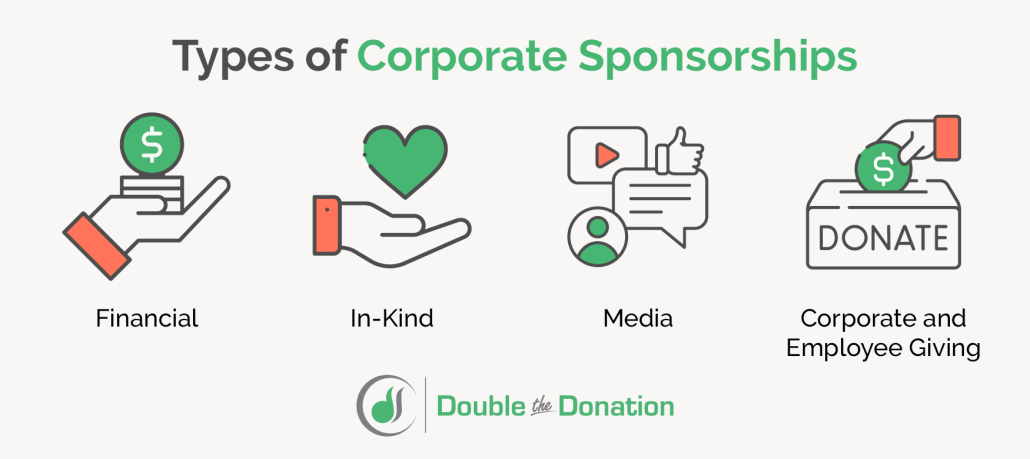
Securing corporate sponsorships involves building relationships with corporate prospects on top of all the other important work you’re doing to raise support for your nonprofit. But these partnerships are well worth it, as corporate giving can be an invaluable source of revenue, positive social image, and ongoing support.
In this article, we’ll discuss some corporate sponsorship best practices your organization can leverage to secure the best partnership suited to your cause, as well as some of the top corporate sponsors. We’ll cover the following topics:
Understanding the importance of corporate sponsorships is just the beginning. Securing the right corporate sponsorship is another story entirely. Let’s get started!
What is a Corporate Sponsorship?
A corporate sponsorship is a form of support nonprofits receive from corporations to fund events, nonprofit programs, or specific projects. The benefits are twofold: nonprofits receive the help they need to continue serving their missions, while the company receives tax deductions and a positive reputation for its brand.
Corporate Sponsorship Types
Corporate sponsorships can take many forms. Here are a few examples of the most common types:
Financial
This is when a company donates money to sponsor an event or program. Generally, nonprofits recognize the company through various event materials, such as signage, merchandise, and online advertising, in exchange for its support.
In-Kind
An in-kind sponsorship involves a company donating goods or services to an event or project. For example, a restaurant might provide catering services, or a spa may donate free spa packages as a raffle prize.
Media
Some companies cover the cost of promoting a nonprofit event through media sponsorships. This could include radio promotions, TV ads, or printed advertisements.
Corporate and Employee Giving
Beyond typical corporate sponsorships, other forms of corporate giving can help your nonprofit. These include automatic payroll deductions, volunteer programs, and corporate matching gifts. Read more about these below!
Match More Gifts With Double the Donation
Get a sneak peek of the industry-leading matching gift automation solution, Double the Donation.
Benefits of Corporate Sponsorships
Corporate sponsorships benefit both companies and nonprofits in the following ways:
Benefits for Nonprofits
Benefits for Companies
Considerations to Keep In Mind Before Getting Started
Clearly, corporate sponsorships benefit all parties. But before getting started, there are a few things to be aware of to prepare for a sponsorship:
Don’t let these factors prevent your nonprofit from taking advantage of the benefits of a corporate sponsorship. Proper due diligence, careful documentation, and clear communication can help you manage and even prevent these concerns altogether.
How to Find Corporate Sponsorships
When it comes to asking for corporate sponsorships, be intentional about who you choose to work with. As you research potential partners, consider the following tips to narrow down your search:
Contact Local Businesses
Start local! Approach the businesses in the immediate area of your event. To find candidates, use resources like:
These businesses are more likely to see the value in sponsoring an event in their own community, which can greatly impact their decision to partner with you.
Seek Out Shared Values
A corporate partner should align with your organization’s mission. For instance, if you’re an environmental organization, you should work with a corporation that values sustainability, environmental conservation, and other related issues. Your organization could end up losing credibility if you partner with a corporation that substantially harms the environment or has received bad press.
Browse a business’s website, social media platforms, and other resources to get a feel for its values. Many companies list their values publicly. Then, discuss these values with the company’s point of contact before confirming the sponsorship to ensure you understand what they mean in practice.
Look Online
Search for lists of companies that donate to nonprofits online. These companies have a reputation for their philanthropic behaviors, so they might be more interested in forming a partnership than a business with no previous interest in charitable giving. You might find one you haven’t thought of before.
Not to mention, corporate giving databases like Double the Donation can provide detailed information about available corporate sponsorships, grants, and more.
Leverage Points of Contact
If your board members, key donors, or other members of your organization have connections or contacts at a particular company, ask them to reach out directly and request a sponsorship. Or, at the very least, see if they’d be willing to make a warm introduction for your organization. This is where your donor employment information can really come in handy!
Additionally, companies may be looking to fulfill the ethical and philanthropic obligations laid out in the pyramid of CSR.
Top 10 Companies With Excellent Corporate Sponsorship Programs
Zipsprout’s guide to corporate sponsors shares some interesting corporate sponsorship statistics. We’ve combined these statistics with insights from our robust database of matching gift and volunteer grant programs to highlight the best corporate sponsorship and relationship opportunities.
Check out these top corporate sponsors!
1. Wells Fargo
Wells Fargo has sponsored 2.89% of nonprofits in a database of nonprofits that publicly list their sponsors, placing them at #1 on the list of top corporate sponsors.
Corporate Giving Information
Wells Fargo offers both matching gifts and volunteer grants. The company matches up to $2,000 per employee at a 1:1 ratio.
2. State Farm
State Farm has sponsored 1.07% of nonprofits in a database of nonprofits that publicly list their sponsors, placing them at #5 on the list of top corporate sponsors.
Corporate Giving Information
State Farm offers both a matching gift program and volunteer grant opportunities. The company matches up to $4,500 at a 1:1 ratio for full-time employees.
3. PepsiCo
PepsiCo has sponsored 0.98% of nonprofits in a database of nonprofits that publicly list their sponsors, placing them at #6 on the list of top corporate sponsors.
Corporate Giving Information
PepsiCo matches employee donations up to $10,000, with a minimum donation amount of $25. The company also offers a volunteer grant program.
4. U.S. Bank
U.S. Bank has sponsored 0.97% of nonprofits in a database of nonprofits that publicly list their sponsors, placing them at #7 on the list of top corporate sponsors.
Corporate Giving Information
U.S. Bank matches up to $3,000 in donations made by active full- and part-time employees at a 1:1 ratio. The company also offers a “Dollars for Doing” volunteer grant program.
5. Bank of America
Bank of America has sponsored 0.92% of nonprofits in a database of nonprofits that publicly list their sponsors, placing them at #8 on the list of top corporate sponsors.
Corporate Giving Information
Bank of America offers matching gifts and volunteer grant opportunities. The company matches up to $5,000 in donations to most nonprofits at a 1:1 ratio.
6. Budweiser/Bud Light (Anheuser-Busch)
Budweiser has sponsored 0.76% of nonprofits in a database of nonprofits that publicly list their sponsors, placing them at #9 on the list of top corporate sponsors.
Corporate Giving Information
Anheuser-Busch’s matching gift program matches donations up to $5,000 per year at a 1:1 ratio.
7. Clif Bar
Clif Bar has sponsored 0.74% of nonprofits in a database of nonprofits that publicly list their sponsors, placing them at #10 on the list of top corporate sponsors.
Corporate Giving Information
Clif Bar offers a matching gift program to active employees, matching up to $2,500 in donations at a 1:1 ratio.
8. The Coca-Cola Company
The Coca-Cola Company has sponsored 0.72% of nonprofits in a database of nonprofits that publicly list their sponsors, placing them at #11 on the list of top corporate sponsors.
Corporate Giving Information
The Coca-Cola Company offers a very generous matching gift program. The company contributes up to $20,000 per employee per year, matching at a 2:1 ratio.
9. Walmart
Walmart has sponsored 0.68% of nonprofits in a database of nonprofits that publicly list their sponsors, placing them at #12 on the list of top corporate sponsors.
Corporate Giving Information
Walmart matches up to $25,000 in donations made by executive-level employees at a 3:1 ratio. The company also offers a volunteer grant program.
10. McDonald’s
McDonald’s has sponsored 0.67% of nonprofits in a database of nonprofits that publicly list their sponsors, placing them at #14 on the list of top corporate sponsors.
Corporate Giving Information
McDonald’s offers a very generous matching gift program, matching up to $10,000 in employee donations (depending on role) per year at a 1:1 ratio.
How to Ask for a Corporate Sponsorship
Once you’ve identified corporations you want to partner with, it’s time to plan how you’ll approach them. Forming the right ask depends on your goals, who you’re reaching out to, and when you plan to make contact. Here’s a helpful list of strategies to help you make the ask:
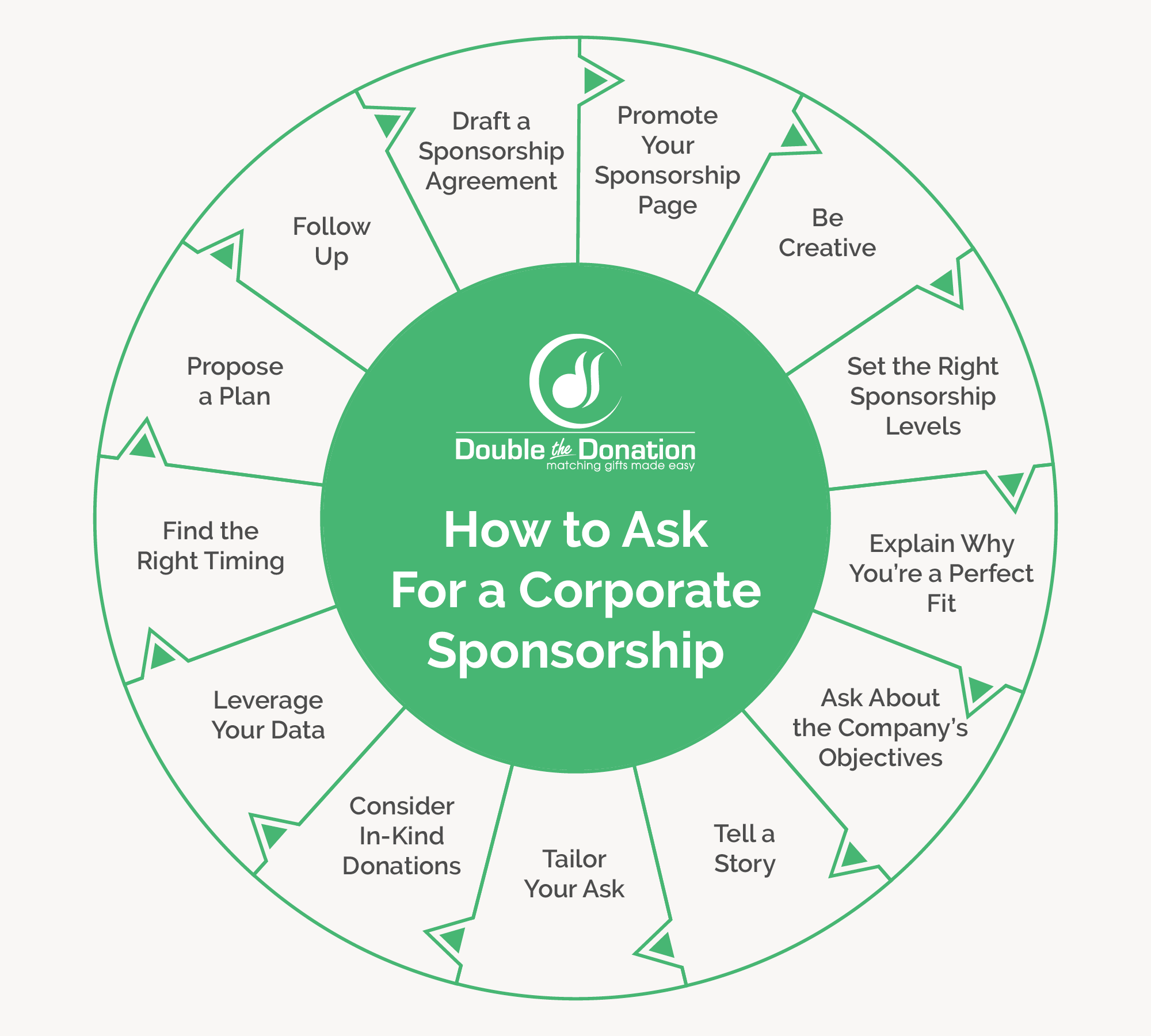
Promote Your Sponsorship Page
Creating a sponsorship page on your nonprofit’s website is a great way to condense the must-know information about sponsoring your organization. Include information like:
Then, promote this page across different channels, such as social media and paid advertising platforms like Google Ads. You can tap into paid advertising for free with the Google Ad Grant! If you apply and are approved, you can promote content like your sponsorship page on Google Search Results for relevant keywords.
Finding the right keywords can take some work, but you can always turn to a professional to handle the work for you. A Google Ad Grants expert like Getting Attention can help you optimize your sponsorship landing page and promote it using Google Ads.
Be Creative
You can ask a company to sponsor just about anything. Use aspects of your event that already exist, and turn them into sponsorship perks. Then, be sure to position them as excellent sponsorship opportunities for your potential partners.
Set the Right Sponsorship Levels
Just like you receive a variety of donation amounts from individual supporters, establish multiple levels of sponsorship for corporations to agree to. If you have an event with hundreds or thousands of people, make sure your sponsorship levels are high enough (such as $1,000 and up). You don’t want sponsorship to be priced so high that no one will want to participate, but by keeping levels elevated, sponsors will feel like the event is well-run and that you have confidence in what you’re doing.
On the other hand, if you’re planning a smaller event and have difficulty securing a large sponsorship, consider offering a lower sponsorship level with fewer perks. For instance, you could offer a $100 level for smaller businesses not interested in the larger sponsorship opportunity.
Explain Why You’re a Perfect Fit
As you make your ask, explain how this corporate partnership will contribute to building up the company’s brand. Do your missions align? What will working with your nonprofit help the company achieve in terms of its own goals? Keep these in mind and communicate them as clearly as possible.
Ask About the Company’s Objectives
That said, asking the company directly about its objectives and priorities demonstrates that you’re genuinely interested in bringing value to the partnership. Remember, your corporate sponsors have objectives, or “missions,” of their own. They’ll want to know they’re supporting a nonprofit that aligns with these goals and that the sponsorship can help them achieve them.
Tell a Story
Explain to potential sponsors how their sponsorship and support can directly impact someone as part of your mission. For instance, “$1,000 will help us provide meals to 5 families of 4 for a week.” Additionally, share how last year’s sponsors were able to help your organization accomplish its goals.
Tailor Your Ask
Rather than using one main template and filling in names, make your ask personal and write individualized letters. These should be addressed to a relevant person at the company who is most likely to be receptive to hearing about your cause. Make sure you do your research on who to ask. Go beyond just marketing contacts and speak to anyone who will sympathize with your mission and also be in a position to create a plan of action!
Consider In-Kind Donations
If a business declines to offer a monetary sponsorship, consider asking for a non-monetary sponsorship instead, such as coupons for free services on event day. You can also request that a portion of their proceeds on the event day be donated back to the organization. A business in the area could serve as a location for the kick-off party, packet pick-up, or after-event party.
You can also reach out to companies to provide services you’ll need at the event, such as photography, DJ/entertainment, signage, food, portable toilets, and tent/chair rentals. The value of their goods or services can certainly equate to a sponsorship level.
Leverage Your Data
Always back up your corporate sponsorship asks with supporter data. Determine what demographics a sponsor is targeting, and provide them with information about your event that would be relevant. For example, if a company tends to target women aged 50 to 60, let them know how many people or what percentage of participants attending your event fall into that group.
Meanwhile, your donors’ employment information can come in handy here, too! If a company’s staff are already supporting your cause, let the company know how they can get deeper involved while growing employee engagement.
Find the Right Timing
The timing of your sponsorship ask is important. A lot of larger companies earmark a specific amount of money each calendar year for charitable giving, so be sure to ask when is the best time for them to consider a sponsorship.
Oftentimes, you have to get your ask in very early to even be considered. Other times, you have to adjust your strategy to the business you’re reaching out to. For instance, if you’re reaching out to an accounting firm during tax season, you’re most likely not top-of-mind, and your request may go unanswered.
Propose a Plan
Part of crafting an appealing sponsorship ask means outlining your campaign initiatives and success metrics. This means defining your fundraising goal and the impact it will have first and foremost.
As mentioned before, use numbers and data to support your proposal. But also be sure to define your success metrics and use KPI benchmarks that show when you’ve achieved your fundraising goals. Be specific about how your organization plans to meet its objectives, and link this process to ongoing projects, as well.
Draft a Sponsorship Agreement
The biggest thing that will demonstrate that you’re professional and committed to the partnership is a sponsorship agreement. It should be written down to outline your goals, expectations, and other deliverables for your organization and the company. It’s also a good idea to include how you’re going to recognize the company for its support, such as through advertising materials, merchandise, or event printouts.
Follow Up
Haven’t heard back? Don’t give up! Continue to communicate with companies after you’ve reached out with a corporate sponsorship request. Always check back to ensure someone has received your call, email, or letter. If not, ask to speak to the appropriate person at the company, and/or resend your ask to that person.
How to Cultivate Relationships with Corporate Sponsors
Once you’ve secured your corporate sponsorship, don’t let the relationship fall by the wayside! In addition to presenting your partnership in a professional light, continuing to recognize and work with your sponsor can have a huge impact on your organization.
Here are some effective ways to work with a sponsor after they’ve agreed to support your cause:
Treat Them Like Part of the Team
Treat your corporate sponsors like part of the team, because they are part of the team. Many sponsors will feel more engaged and recognize that they’re getting more from their sponsorship if they hear from you often. This doesn’t mean sending them an email every day, but rather, treating them like a team member.
Use the same engagement tools and approaches you use with participants to connect with your sponsors. For fundraising events, offer them a free team captain registration, help them get their page set up, and provide fundraising coaching. The more a sponsor raises and the larger their team, the more exposure they will get. This will in turn make them feel like they’re getting more out of the sponsorship.
Pay Attention to the Little Things
Yes, big perks matter, but the little touchpoints make a big difference, too. Send a handwritten thank-you letter or a note from a participant or beneficiary of your cause’s work. If the sponsor also fundraised for your campaign, create a top fundraisers certificate that you send to them by mail.
These little touchpoints show that you acknowledge the importance of their support, yet the cost is minimal, which demonstrates good stewardship by not wasting the sponsor’s money.
Thank Your Sponsors Publicly
Feature sponsor logos and information in your event materials, such as merchandise, pamphlets, and online advertisements and emails. Then, give a shoutout on social media! Tag their company or business page, and publicly thank them in a post.
This will help your sponsor gain exposure as a reward for supporting your event, and it will also help solidify your partnership as beneficial and worthwhile in terms of the company’s branding. Most likely, the company will then re-post your original post to its full audience to help your event reach new constituents.
Additional Corporate Giving Programs
Corporate sponsorships are a fantastic source of funding and support for your nonprofit’s events and projects. But you should also research other forms of corporate philanthropy. Especially when combined with a corporate partnership, other types of philanthropy can maximize your fundraising revenue and keep your supporters engaged.
Of course, managing different areas of workplace giving like matching gifts, volunteer grants, payroll giving, and more can be tricky if you don’t have a centralized platform. Seek out software that can help you identify opportunities, collect data, and share insights for oft-overlooked types of corporate giving. This way, you’ll be able to capitalize on more opportunities for support, growing your funding and support through one organized database.
Here are a few of the different types of corporate giving opportunities your nonprofit can seek out and manage with software:
Matching Gifts and Fundraising Matches
Corporate matching gifts are the most popular type of corporate giving program with more than 26 million individuals working for companies with matching gift programs.
Through these programs, companies match the donations their employees make to eligible nonprofits. Typically, these matching gifts occur at a 1:1 ratio, but some companies will match at a higher rate. This means that your donors’ gifts could be doubled (or even tripled!) at no additional cost to the supporter.
Additionally, some employers match funds their employees raise on behalf of a nonprofit. For example, if you hold a walk-a-thon and an employee raises $250 in pledged donations, the match would bring it to a grand total of $500!
If you’ve already set up a partnership with a company, their employees will be encouraged to donate to your cause. While they are a popular form of corporate giving, matching gifts are still an overlooked revenue source. That’s why it’s important to raise awareness among all of your donors and supporters, whether they’re connected to known sponsors or not.
To help raise awareness among your supporters about matching gifts, consider investing in matching gift software. A solution like Double the Donation offers:
These are just a few of the features that Double the Donation’s matching gift solution offers to spread awareness of matching gifts, remind employees to apply for them, and allow you to take advantage of this key revenue stream.
Corporate Grants
Corporate grants are gifts that businesses make to nonprofit organizations, usually for a specific purpose. Like other grants, these may involve an application process and often require your nonprofit to report how the grant was spent and the impact that funding had.
These grants can vary in size and scope, and they may be given in the form of:
When it comes to finding corporate grants for your nonprofit, start with corporations you’ve already worked with during event sponsorships or other partnerships. Additionally, check online grant directories to source new funding opportunities.
Volunteer Grants
When you’re running your mission-relevant programs or any kind of fundraising event, it’s likely that your team will need volunteer assistance. But what if there was a way to turn these already beneficial volunteer hours into another source of fundraising revenue?
Volunteer grants are another common form of corporate philanthropy in which companies provide monetary grants to organizations where their employees regularly volunteer. If you fold this into your already established corporate partnerships, you may very well end up with extra funds for your mission!
Ask corporate sponsors to encourage their employees to volunteer at your event—especially if those volunteers offer specific skill sets that can benefit your cause. If the company also offers a volunteer grant program, this means you’ll get much-needed help at the event itself and you’ll raise more money.
Even if your volunteers don’t come from corporate partners, encourage them to look up their eligibility for a volunteer grant. Many matching gift databases also offer information about volunteer grants! Double the Donation Volunteering allows volunteers to find their employers’ volunteer grant program details. Embed the search tool into your volunteer page and volunteer registration forms for easy access.
Volunteer Time Off (VTO)
Volunteer time off (VTO) is paid time off that employees can use to volunteer. VTO hours are designated specifically for volunteer opportunities with registered nonprofit organizations, meaning employees can take time off during the workday to help your organization.
These programs provide employees with flexibility and help them fulfill their desire to better their communities. For your nonprofit, VTO policies can bring significant benefits like:
Similar to volunteer grants, you can leverage your partner company’s VTO policy during the sponsorship. For example, employees might take an afternoon off of work to visit your facility the day before an event and help set up. Or, they might return after the event to help you write thank-you notes for donors.
Payroll Giving
Payroll giving, sometimes called automatic payroll deductions, is another perk of building relationships with companies. Employees can arrange to have a certain amount deducted from their paycheck and automatically donated to a nonprofit of their choice.
Some of the top advantages of encouraging employees to engage in payroll giving include:
These recurring donations can make a huge difference for your organization. Like a monthly giving program, they provide sustainable, reliable funding that you can expect each month. This makes budgeting easier and more accurate, helping you plan projects to fulfill your mission and maximize your funding.
In-Kind Donations
As you probably guessed from reading about in-kind sponsorships above, in-kind donations involve companies donating equipment, products, or services, rather than money. This expands beyond your fundraising events. Maybe your team needs marketing or tax assistance. Many companies are willing to provide these services to nonprofits free of charge!
Educating your organization about the various corporate giving programs out there can help boost your fundraising revenue. Pair that with strong corporate partnerships, and you’ll have the resources you need to continue serving your mission!
Developing Mutually Beneficial Partnerships with Auto-Submission
The most successful corporate partnerships are built on a mutually beneficial foundation between charitable organizations and for-profit companies. One of the best ways to improve both parties’ sponsorship outcomes is to make the process as easy as possible for everyone involved. That’s why we recommend implementing corporate giving auto-submission!
Double the Donation’s auto-submission functionality is a groundbreaking development in the world of matching gifts and corporate partnerships. And it can aid nonprofit fundraising in a few key ways.
How Auto-Submission Improves Standard Matching Gift Experiences
Auto-submission makes matching gifts easier than ever for nonprofit organizations, their donors, and the companies that support them. Specifically, it enables eligible individuals to complete their match requests in significantly fewer steps—meaning more matches are ultimately completed and fulfilled.
It also reduces the administrative workload for the nonprofit and business, which allows each group to make a larger impact. Not to mention, auto-submission capabilities include improved reporting practices, complete with new data points that allow organizations to better track matches through the process.
Introducing Custom Matching Gift Partnerships
On the other hand, there’s a wide range of companies that may not feel prepared to jump into a full-fledged matching gift program for their staff. However, they want to find a way to support nonprofit causes and inspire their employees to do the same.
Our recommendation for these types of partnerships is a custom (or “one-off”) matching gift program—where a company will agree to match employee donations to a single organization. These are typically more targeted partnerships than a standard matching gift program, which allows for deepening relationships between a nonprofit and a corporate sponsor. And auto-submission allows these partners to facilitate their offering with minimal lift.
Organizations that use Double the Donation can create custom match programs that are exclusive to their own database tool. And when auto-submission is enabled, employee giving transaction details are automatically passed from the nonprofit’s donation page to the business offering the program.
Additional Resources on Corporate Sponsorships
Corporate sponsorships can have a huge impact on more than just the money your organization brings in. They also affect your organization’s brand recognition, exposure, and credibility. Be sure to choose the right corporate partners for your sponsorships and put in the required research to find the best match.
Looking for even more information about corporate philanthropy? Check out these resources below:
Double the Donation Releases Volunteer Functionality for Corporate Volunteer Benefits
/in Company Updates, About Double the Donation /by Adam WeingerDouble the Donation, the leader in corporate matching gifts automation for nonprofits, is proud to expand its horizons with their new corporate volunteering functionality, designed to help organizations connect their volunteers with volunteer grant and volunteer PTO opportunities provided by their employers.
This corporate volutneering functionality, now available to existing Double the Donation clients, gives organizations the opportunity to use a plugin specifically designed to surface information about volunteer grants, a.k.a. “dollars for doers”, and volunteer time off programs from Double the Donation’s extensive database. Now, donors, volunteers, and other supporters can easily find out if their employer offers special incentives for volunteerism.
Read on to learn more about how your organization can use Double the Donation Volunteering to raise more in volunteer grants or get more supporters through volunteer PTO!
What’s Available within Double the Donation Volunteering?
Double the Donation clients can easily access the corporate volunteering functionality through the top navigation in their account. A new dashboard highlights top volunteer grant programs as well as top volunteer PTO programs. Organizations can also see available resources and templates to help their push for volunteer grants, and can also stay up to date on upcoming events hosted by Double the Donation.
Additionally in the volunteering section of their account, organizations have access to a new plugin that puts volunteer grant and volunteer time off information front and center. Nonprofits can both use the plugin directly from within their account, as well as embed the plugin on their website or integrated volunteer registration forms for visitors to use and search from.
Keep an eye out for updates as Double the Donation adds more features very soon!
Get Started with Double the Donation Volunteering
Double the Donation Volunteering by Double the Donation empowers fundraisers and corporate philanthropy coordinators to deepen their relationships with supporters by exposing them to the benefits companies make available to them.
Ready to learn more about both Double the Donation’s matching gift and corporate volunteer incentive functionality? Request a demo today to learn more about how both can help your organization raise more with every supporter interaction.
About Double the Donation: Automate your matching gift fundraising with the industry-leading solution from Double the Donation. The Double the Donation platform provides nonprofits with tools to identify match-eligible donors, drive matches to completion, and gain actionable insights. Double the Donation integrates directly into donation forms, CRMs, social fundraising software, and other nonprofit technology solutions to capture employment information and follow up appropriately with donors about matching gifts. To learn more about Double the Donation, visit https://doublethedonation.com and request a demo at: https://doublethedonation.com/get-a-demo/
The Future of Matching Gifts: Auto-Submission Functionality
/in About Double the Donation /by Erin LavenderThe nonprofit landscape is continuously changing, and our team at Double the Donation is constantly making improvements to our matching gift solution, Double the Donation Matching, to evolve along with it. To provide users with the best possible software for their fundraising needs, we’re proud to add the latest cutting-edge technology in matching gifts to our platform: auto-submission.
This revolutionary feature makes it easier than ever for donors to complete and submit their matching gift requests to employers by turning a multi-step process into a single click.
Looking to learn more about the functionality? You’ve come to the right place! In this guide, we’ll share everything you need to know to make the most of matching gift auto-submission.
We’re excited to be the leading provider of matching gift technology, and if you or your team has any questions about auto-submission not answered by this guide, our team is more than happy to help.
What is matching gift auto-submission?
Matching gift auto-submission is essentially the automation of the corporate matching gift request process.
Traditionally, for donors to participate in their employers’ matching gift programs, they have to take the following steps:
When developing a matching gift program, companies should eliminate as many barriers to participation as possible. If a company has a laborious and complex matching gift application submission system, employees might not participate in the program.
In contrast to this lengthy process, when donors can automatically submit their match requests, the process looks like this:
With a user-friendly matching gift process, companies can do more good for their communities, better engage employees, and build strong relationships with nonprofits.
Check out the video overview below to learn more and see it in action:
Key benefits of matching gift auto-submission
Streamlining the matching gift process with auto-submission benefits every party involved in the process. Let’s take a look at how auto-submission improves matching gifts for each stakeholder.
Benefits for Donors
Donors appreciate knowing their gifts will go further with matching gifts, but complicated request processes can discourage even the most dedicated supporters. Double the Donation has long worked to streamline the matching gift submissions by:
Now auto-submission functionality brings simplicity to the next level. With auto-submission, corporate employees can give directly to a nonprofit through their website, a peer-to-peer fundraising page, or other donation tool. From there, submitting their match requests to their company is so quick and easy that participating is practically a no-brainer.
Benefits for Nonprofits
The link between an easy matching gift process and greater nonprofit revenue is clear; when more donors successfully submit their matches, more matching gift funds get sent your way.
This means nonprofits can tap into additional income streams to pursue their missions. Plus, since matching gift funds are likely to be unrestricted revenue, nonprofits are free to spend these extra donations on important but underfunded overhead costs. When the process is automated from start to finish, your team can focus on programming rather than chasing down donors.
Benefits for Companies
Companies offer employee programs like matching gifts to increase employee engagement and better appeal to existing and prospective consumers. The more their employees participate in matching initiatives, the more the companies give to nonprofit causes and the better their reputation becomes. When employees see the ease of matching gift auto-submission, their participation in employee giving programs goes up.
Benefits for Corporate Giving Vendors
Corporate giving vendors design software for companies that streamlines and improves workplace giving programs like matching gifts. When vendors offer matching gift auto-submission functionality, they make it easier for companies, employees, and nonprofits to tap into a widespread employee giving program, matching gifts. As a result, these CSR platforms see increased usage and satisfaction among corporate clients who want to optimize their employees’ giving experiences. In the end, this improves these software vendors’ SaaS renewal rates, attracts new corporate clients, and drives up long-term revenue.
The quicker and simpler it is to participate in corporate matching gift programs, the more likely individuals are to take the required steps. As a result, nonprofits and companies alike can expect significantly more match-eligible donations driven to completion, which is a win-win for everybody!
How new auto-submission functionality works
Auto-submission sounds great, but how does it actually work?
We’ve already gone over the basic process, but let’s hone in on a few key steps. Particularly, we’ll look at steps two through four in the following infographic which explains just what the software does with a donor’s employment information.
In the end, corporate matching gifts are paid out to your organization the same way as if an individual had manually submitted their matching gift request on their own. To learn more about how this technology works, check out this video exploring Double the Donation’s auto-submission functionality:
Our trailblazing auto-submission partners
Double the Donation leverages partnerships with other innovative technology providers to expand its services and functionality. Matching gift auto-submission is no different.
Auto-submission is on the rise, and we’re happy to show off three CSR vendors who have partnered with Double the Donation to bring this cutting-edge technology to donors:
Millie
Millie is a social impact platform designed to make workplace giving and volunteering accessible, fun, and impactful. They are big believers that change comes from everyone, and Millie is on a mission to empower businesses of all sizes to start and grow social impact programs. Whether a company has 100 employees, 5,000 employees, or anything in between, Millie helps engage teams with donation matching, volunteer programming, fundraising campaigns, gifting, ERG tools, and more.
Employees of companies that utilize Milie’s software can leverage matching gift auto-submission to submit match requests to their employers more easily. For nonprofits using Double the Donation, donors will be asked on the gift confirmation page to enter their corporate email address. From there, an email will be sent requesting the donor verify their recently submitted donation and subsequent matching gift request, which will then be completed and processed by Millie.
POINT
POINT is known for being a robust yet user-friendly volunteer management app for nonprofits, volunteers, and companies. POINT aims to be an all-in-one solution for corporate social responsibility needs, including volunteering, giving, matching, and partnering.
To leverage matching gift auto-submission through POINT, qualifying donors enter their email address into the POINT app. The email address is automatically verified with POINT, providing the user with a list of nonprofits associated with their app profile to choose from. They will then be asked to select the organization the donation match should be sent to. From there, the submission is processed behind the scenes.
Selflessly
Selflessly helps HR and company culture leaders increase employee engagement through its corporate giving and volunteering software solution. Selflessly makes it easy to make a social impact by providing companies with all the tools they need in one platform. Employees can donate to nonprofits, coordinate volunteer opportunities, create team campaigns, receive matching gifts, and more. They prioritize inclusive workplaces to support all employees and the causes they care about.
Individuals working for companies that use Selflessly to manage their matching gift programs can log into their employer’s Selflessly portal and request a donation match to their favorite organizations. Now, when those organizations utilize Double the Donation’s auto-submission technology, the request process is as easy as entering their corporate email address when giving. Double the Donation and Selflessly will handle the rest!
Discover even more about matching gift auto-submission
Matching gift auto-submission goes a long way toward increasing the number of completed match donation requests. For organizations like yours, that will mean more corporate revenue and engagement opportunities, with fewer eligible gifts slipping through the cracks. And, best of all, your donors are going to love it!
Interested in learning more about matching gifts and best practices your organization can take to increase corporate revenue? Check out these other educational resources: